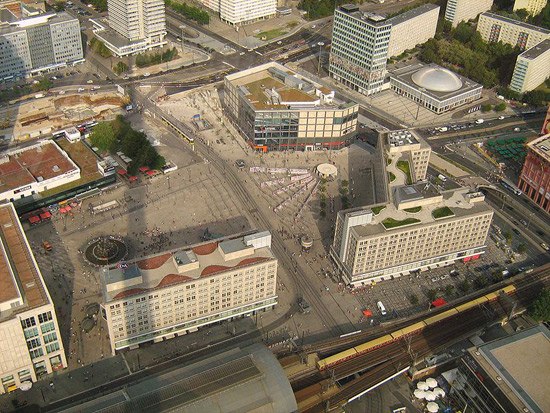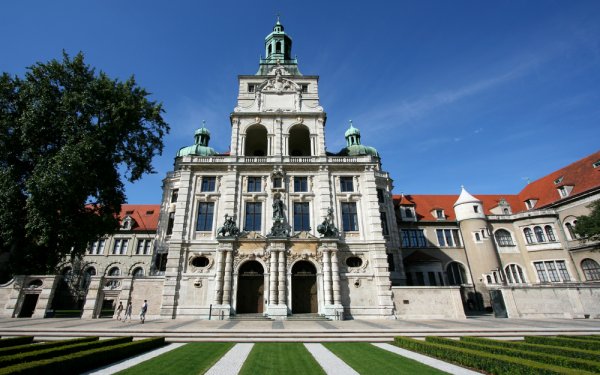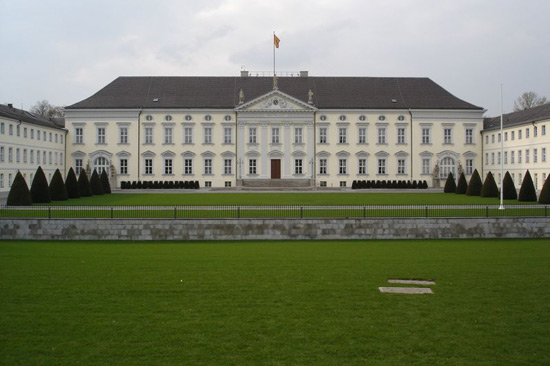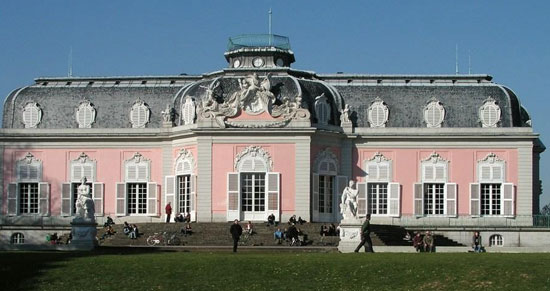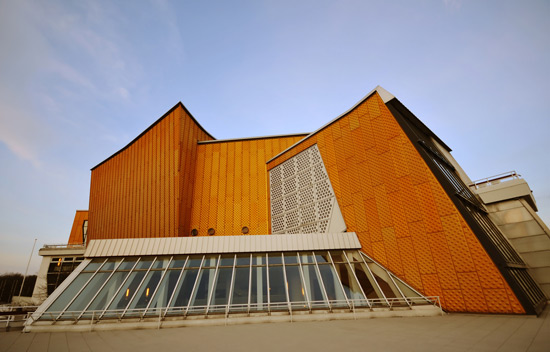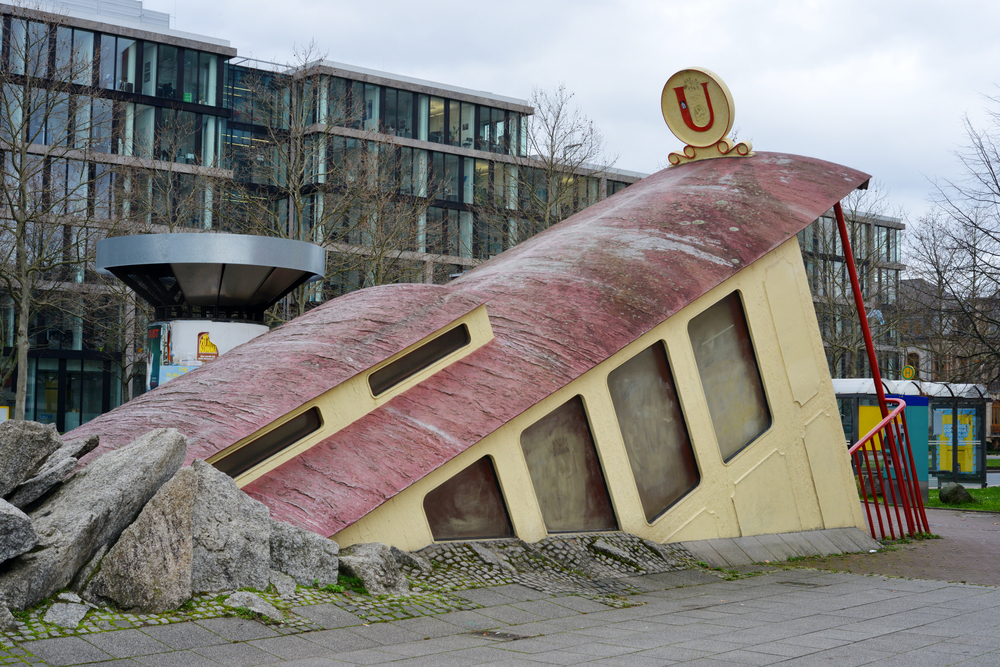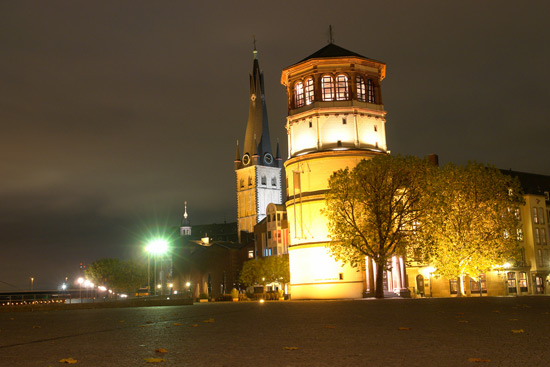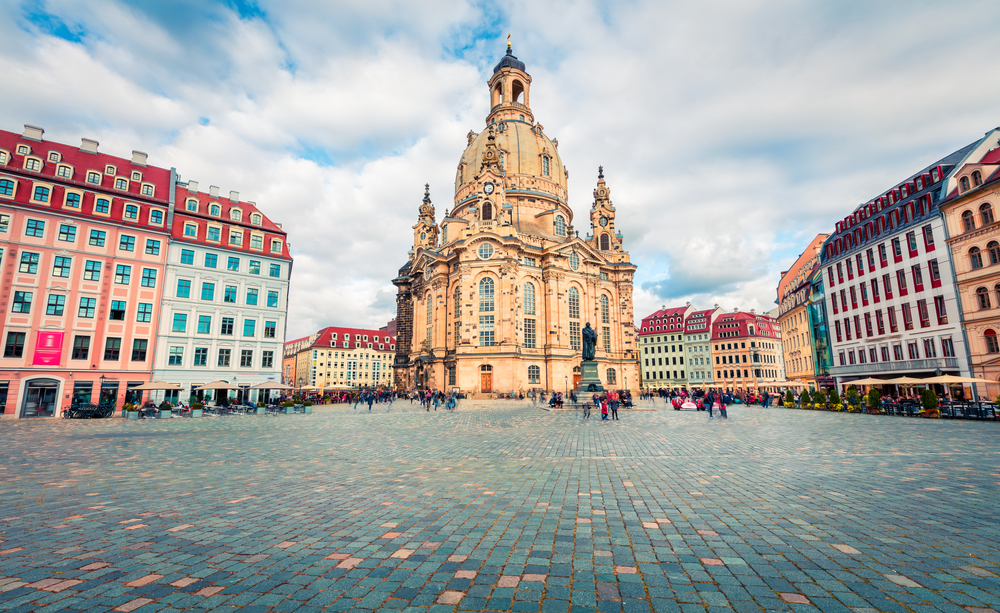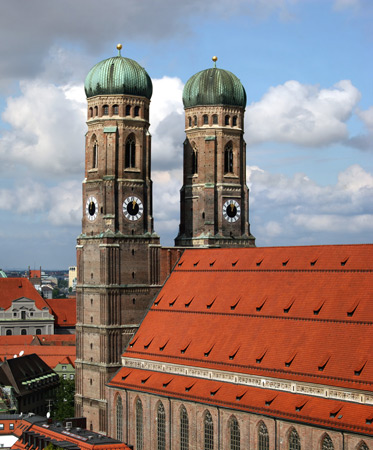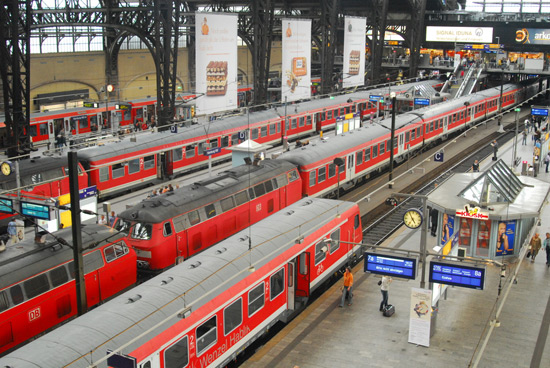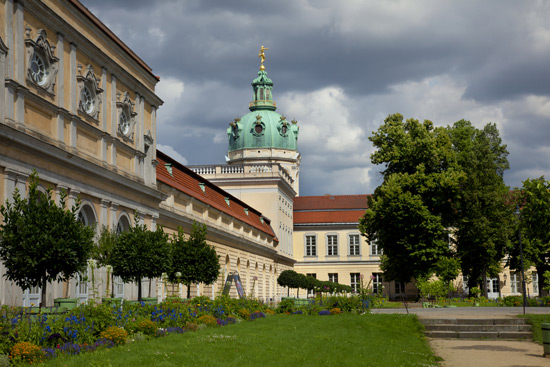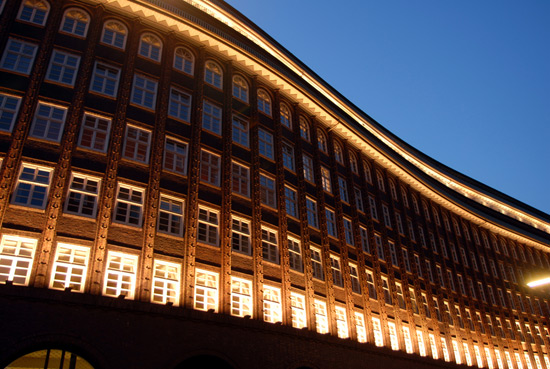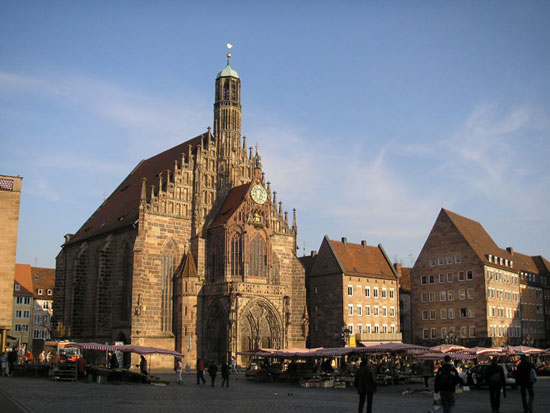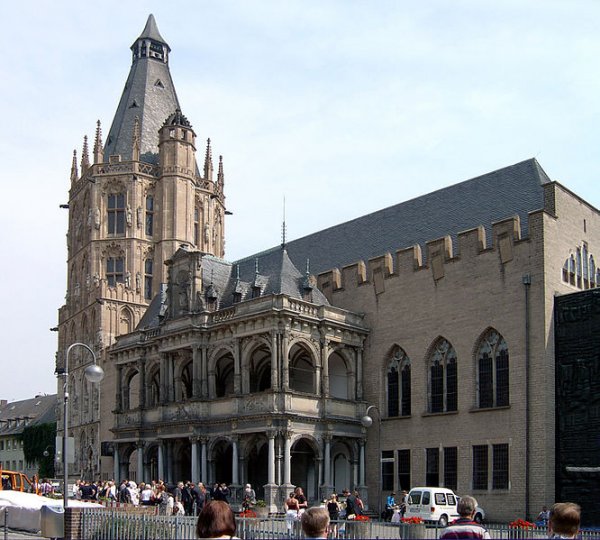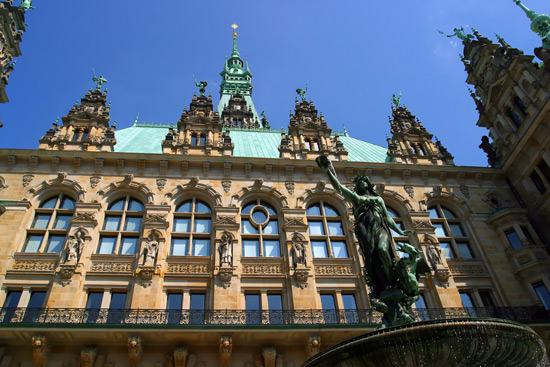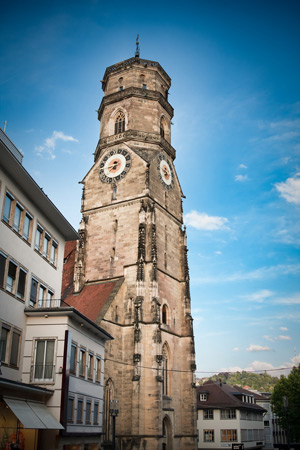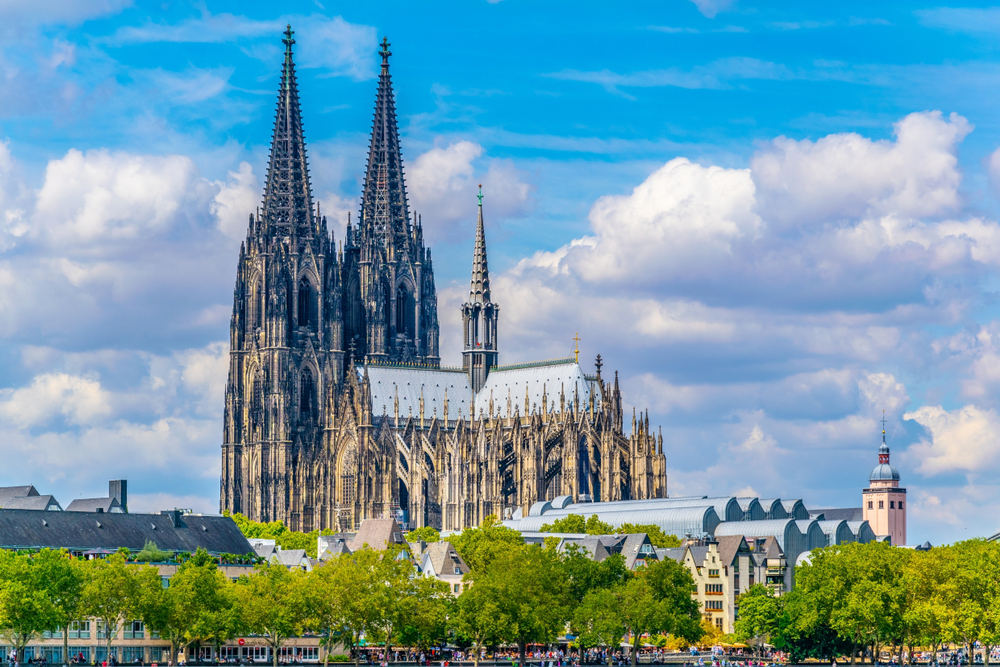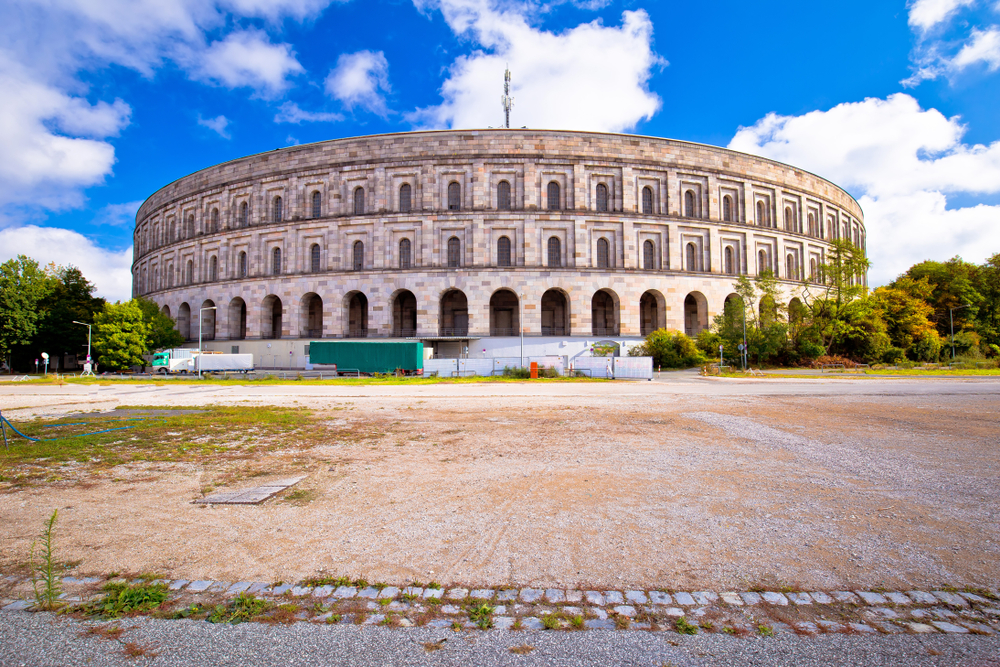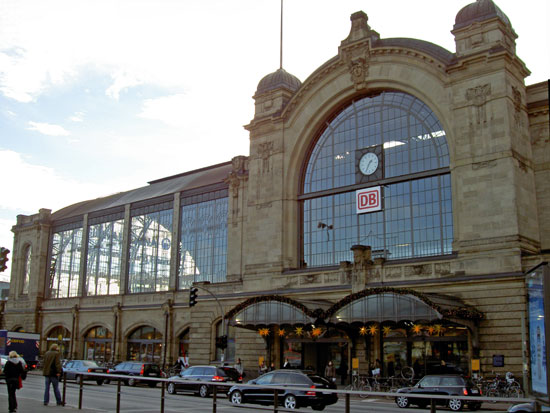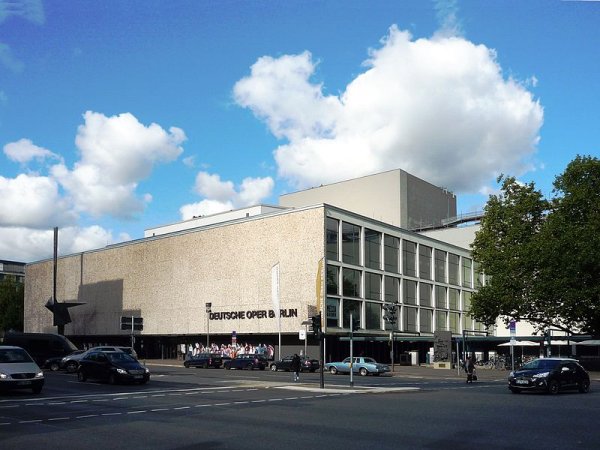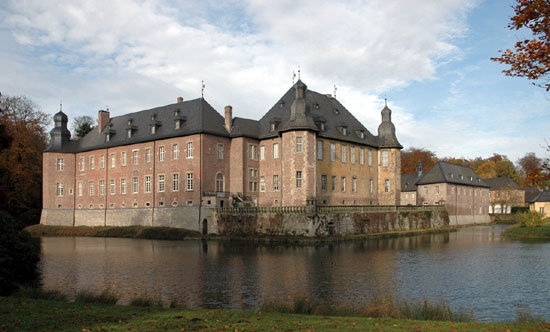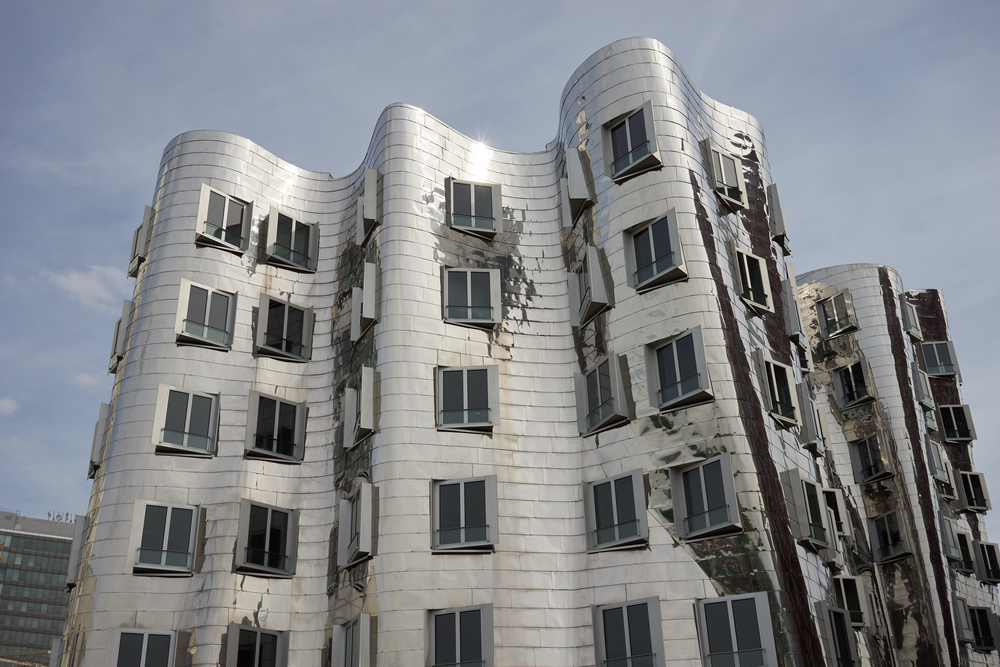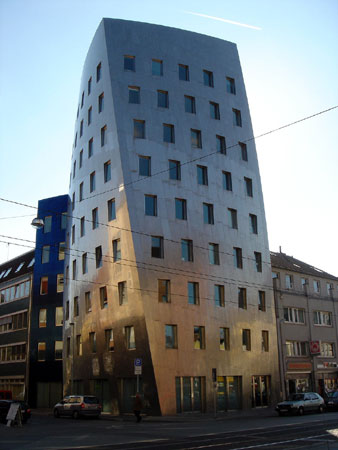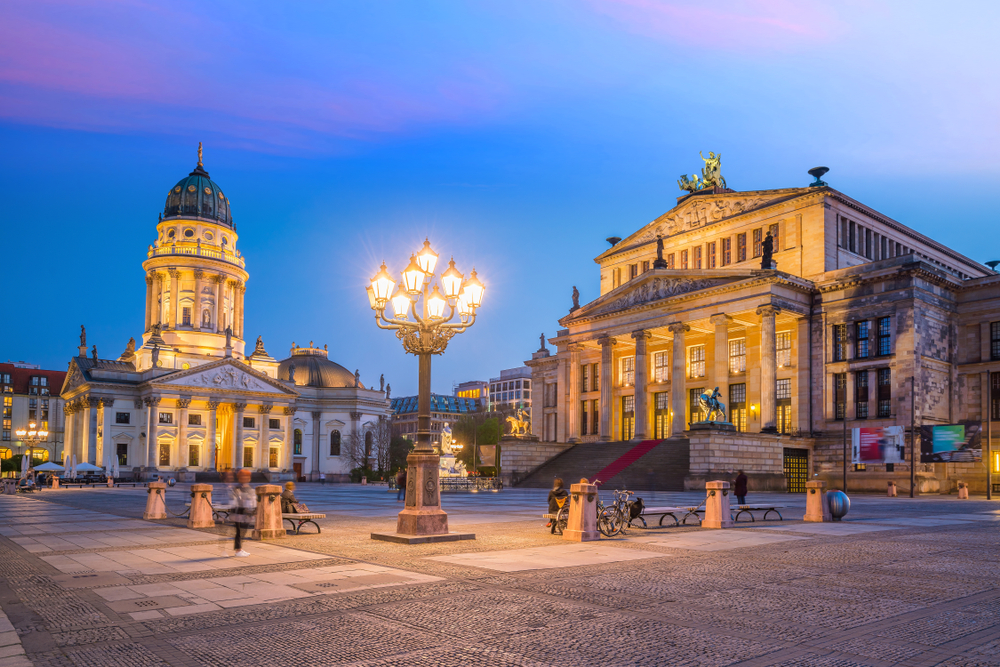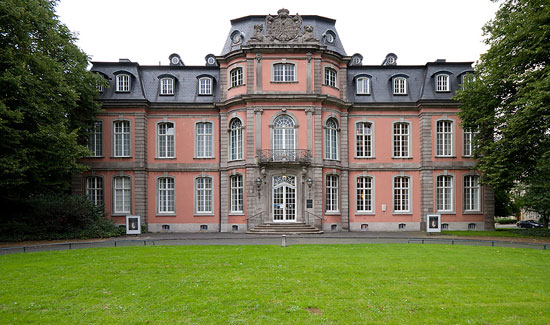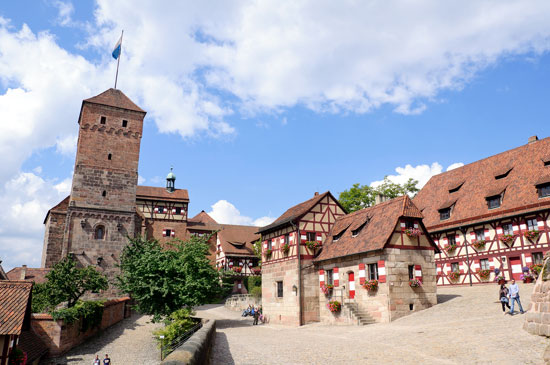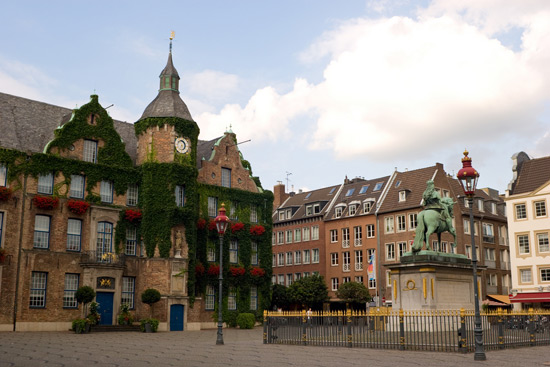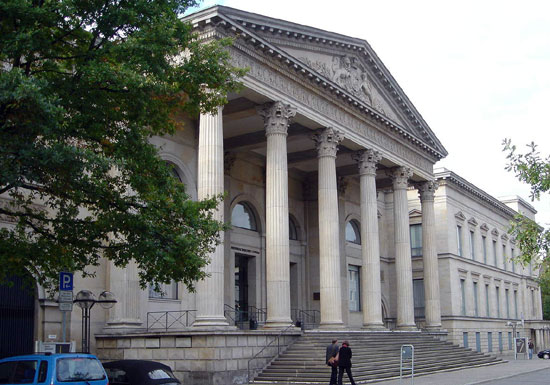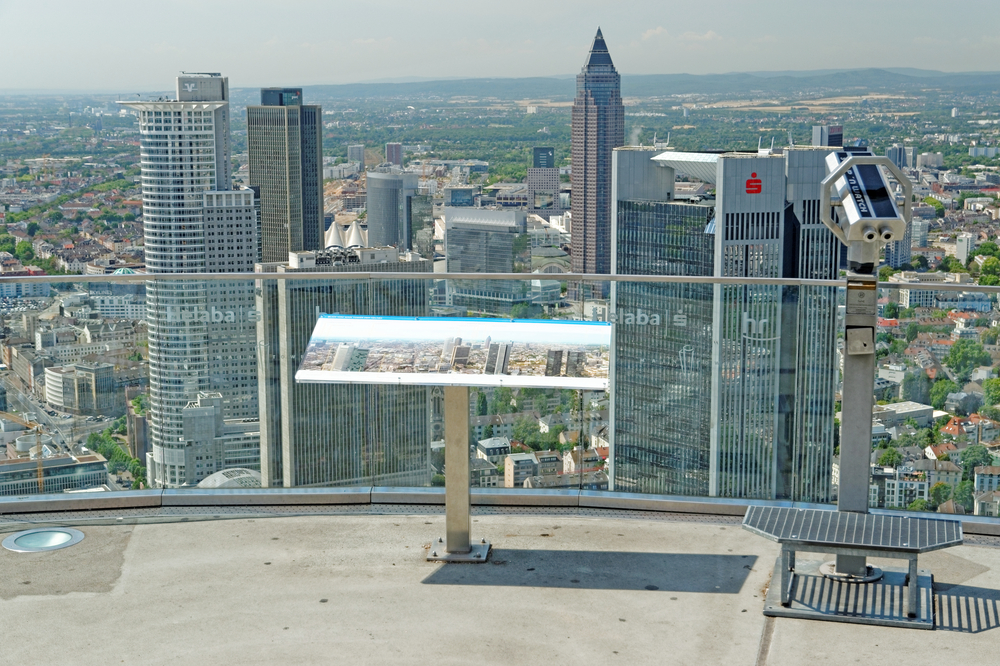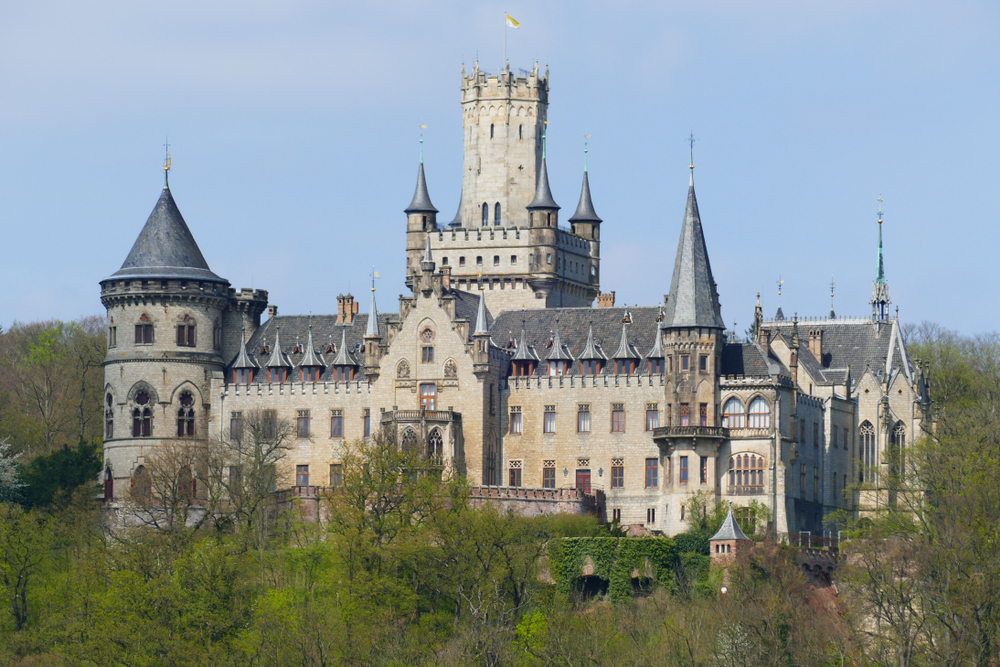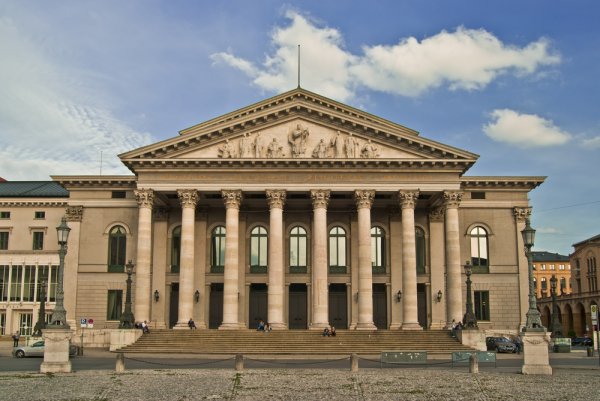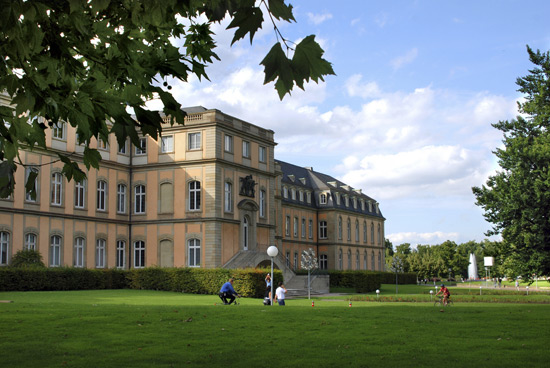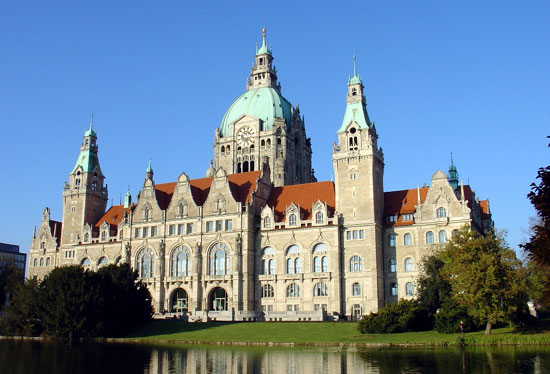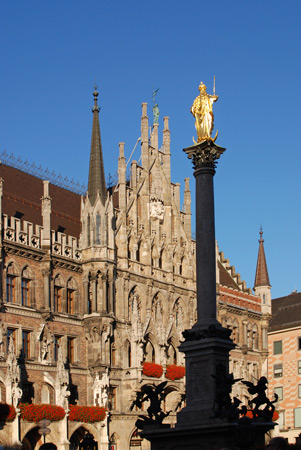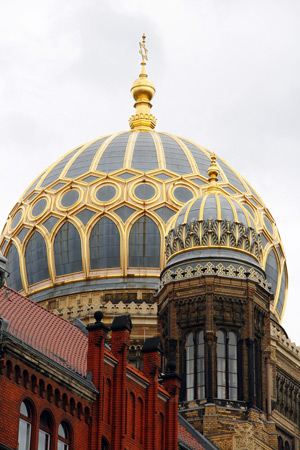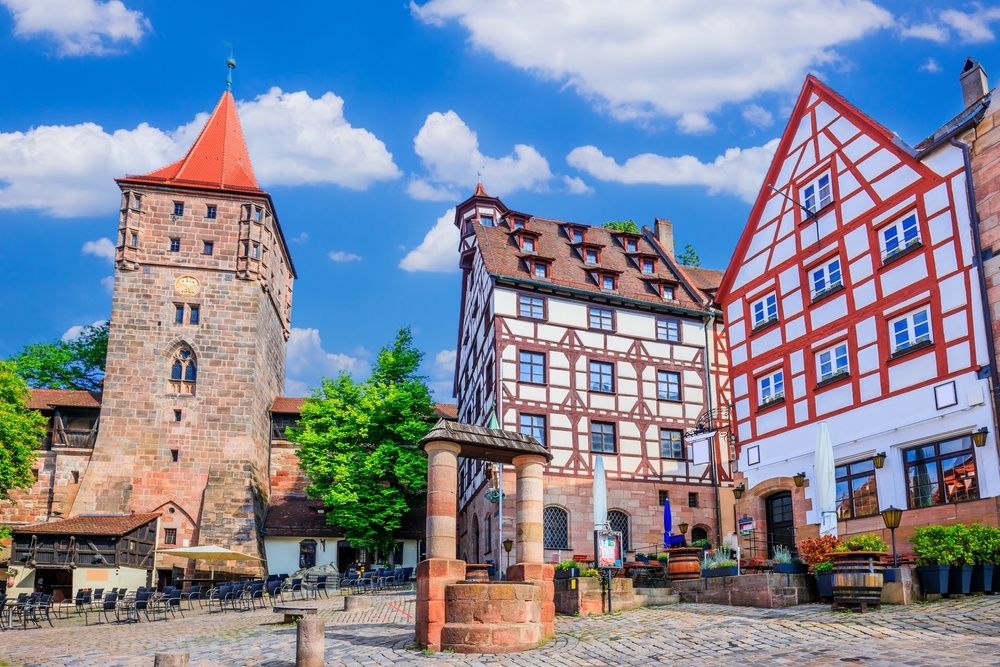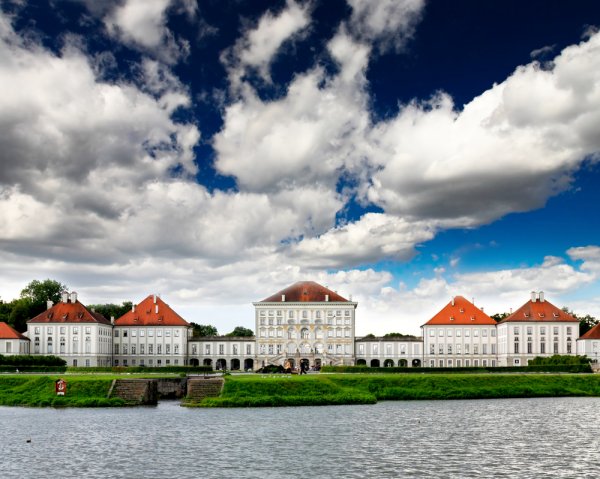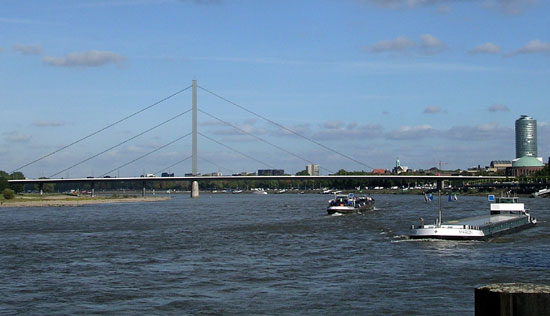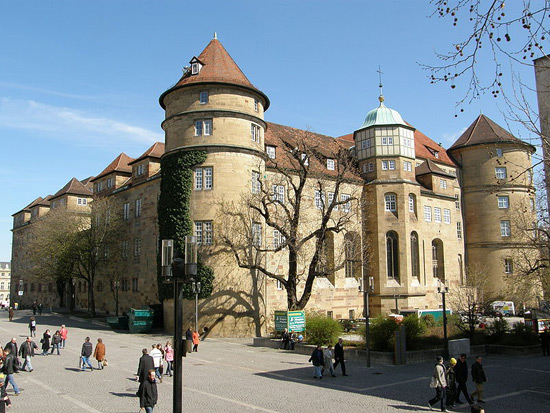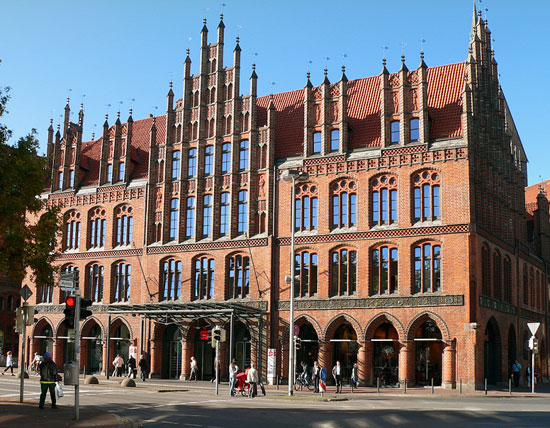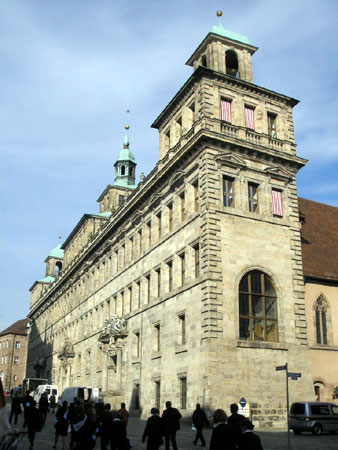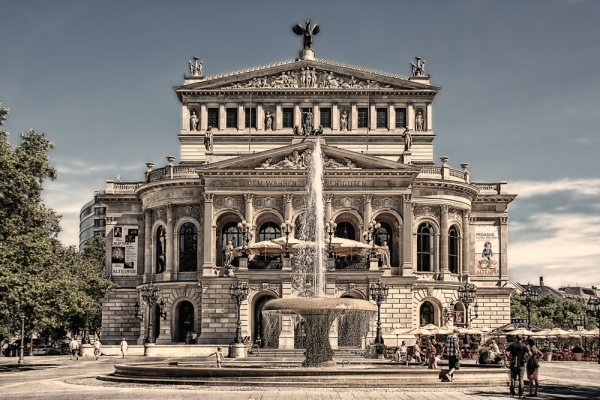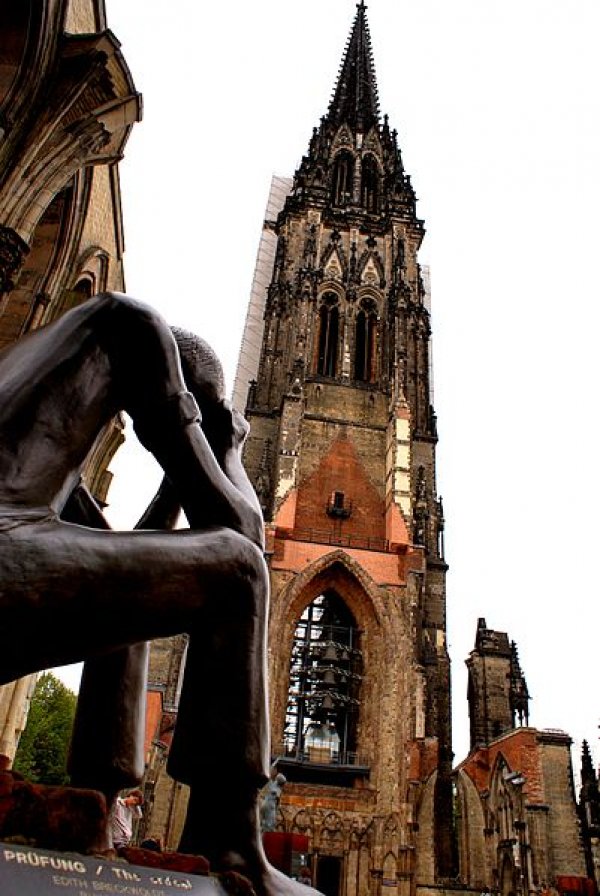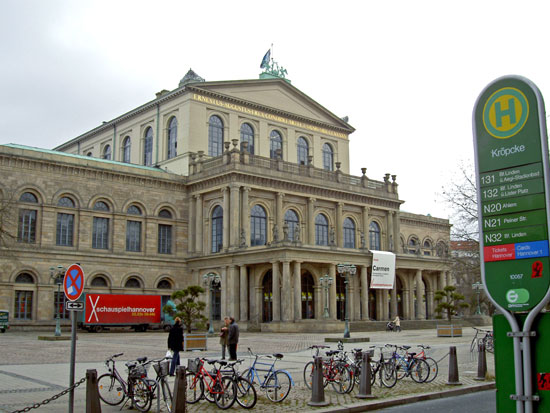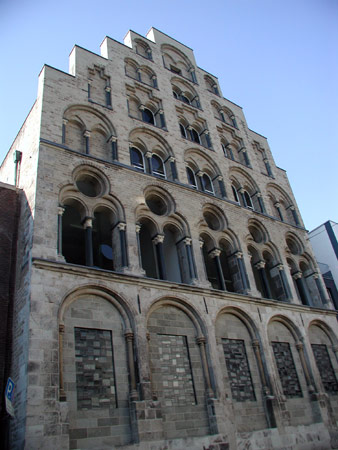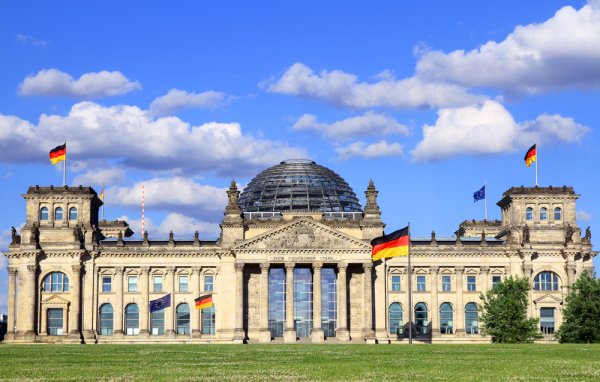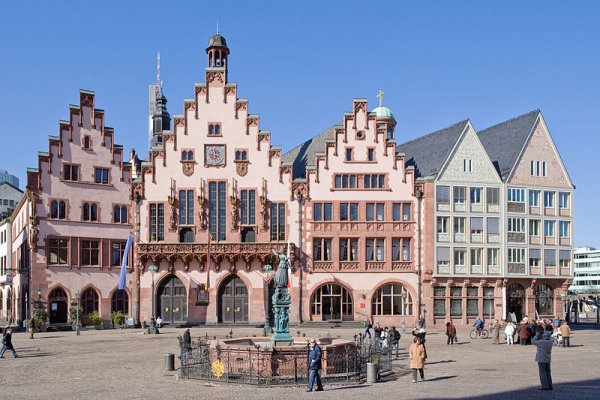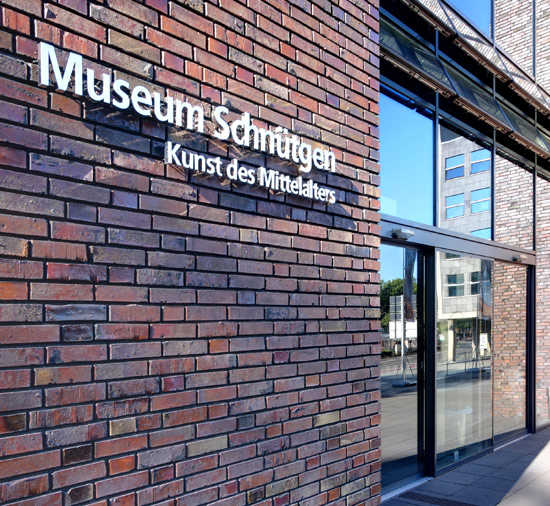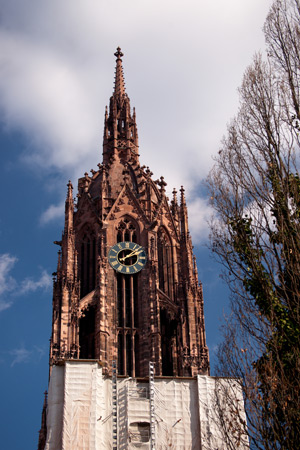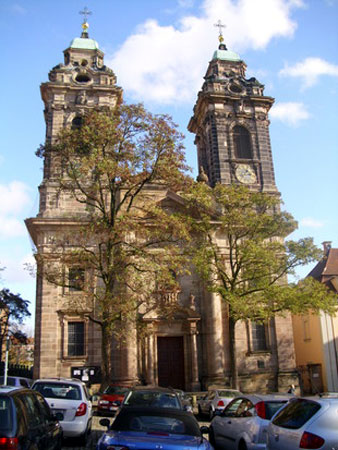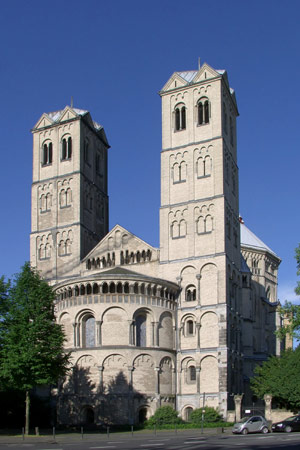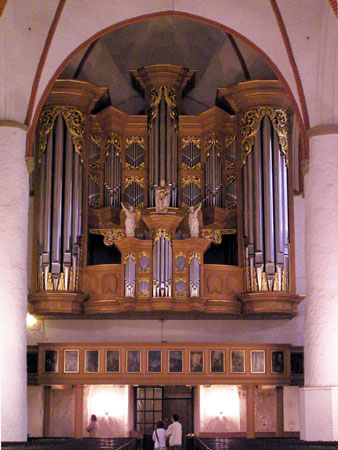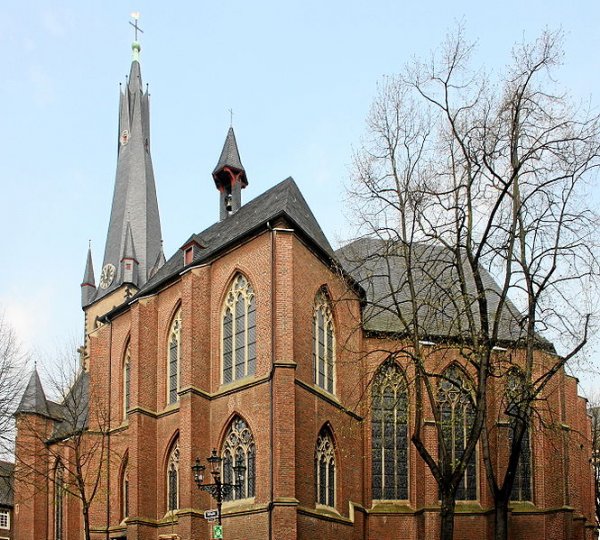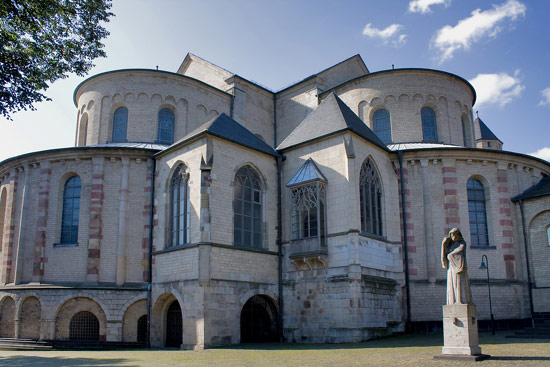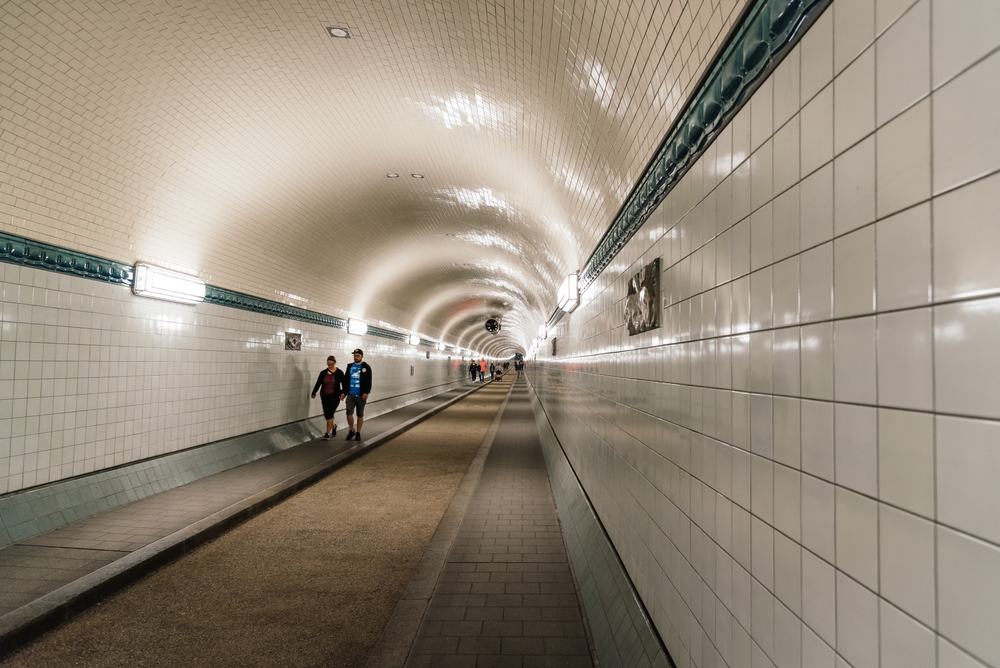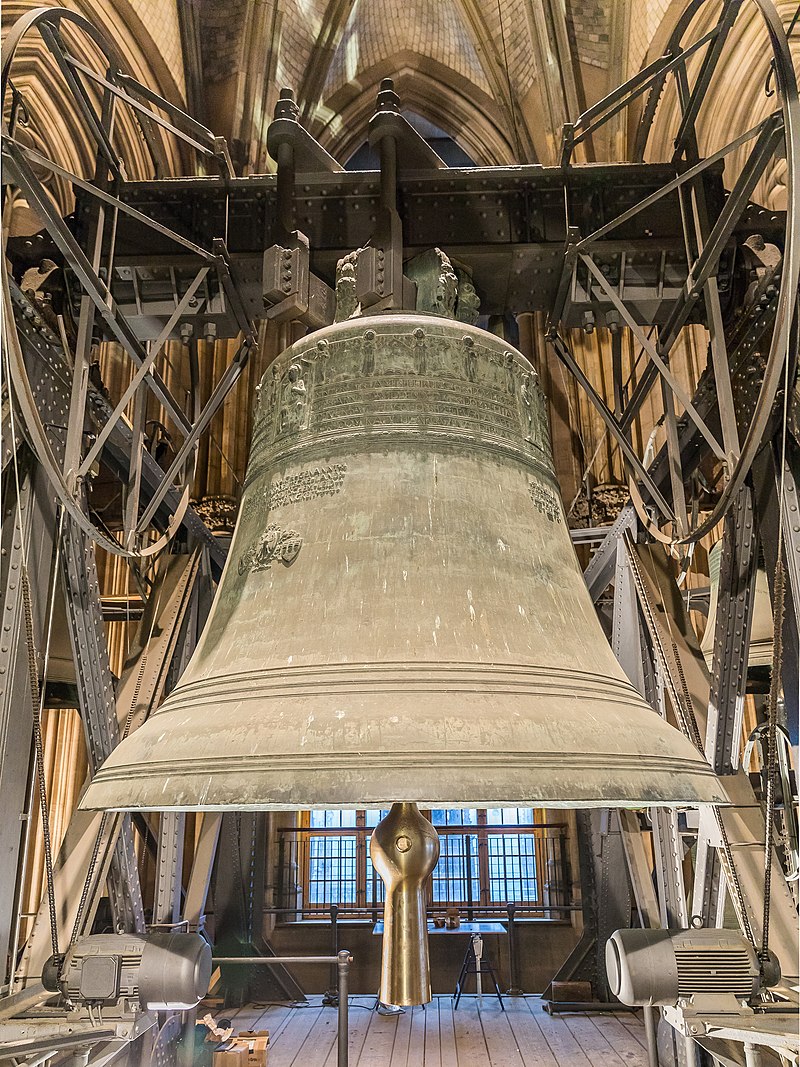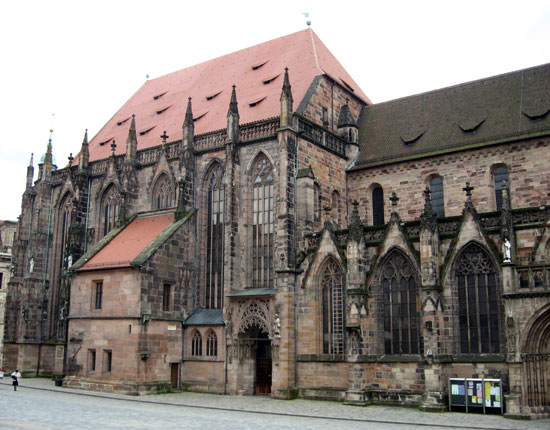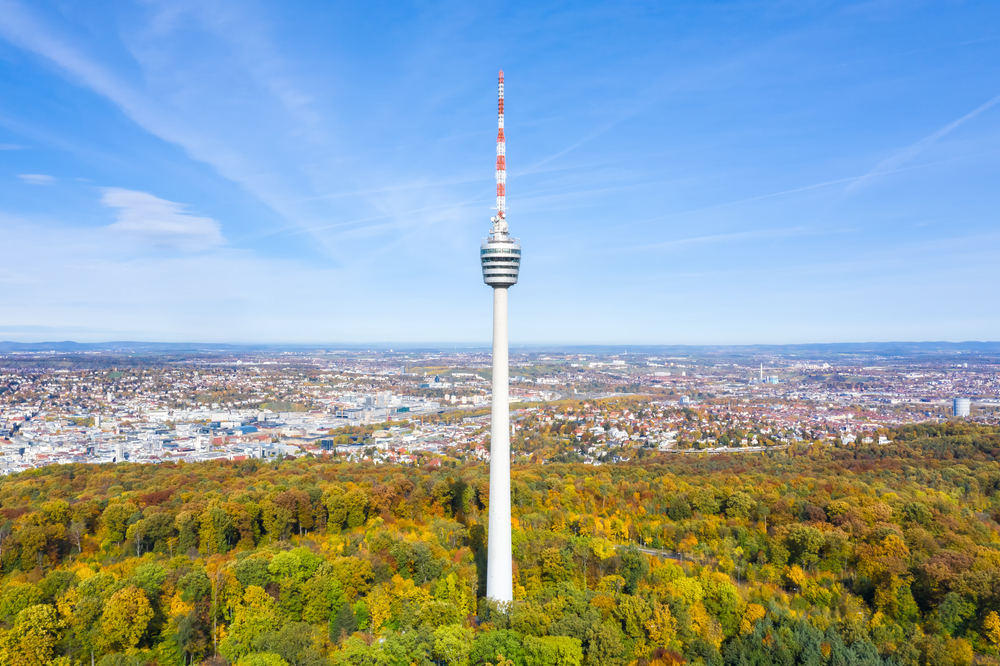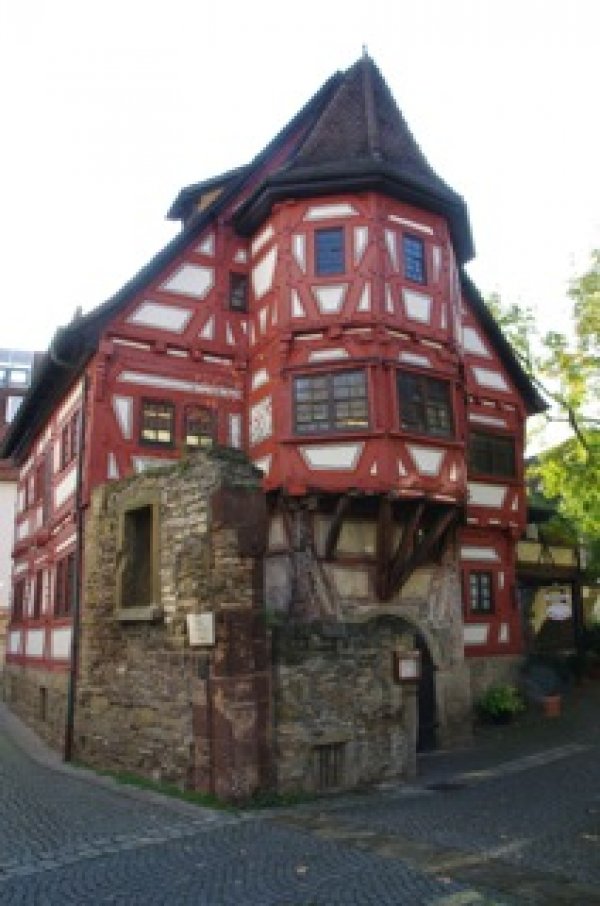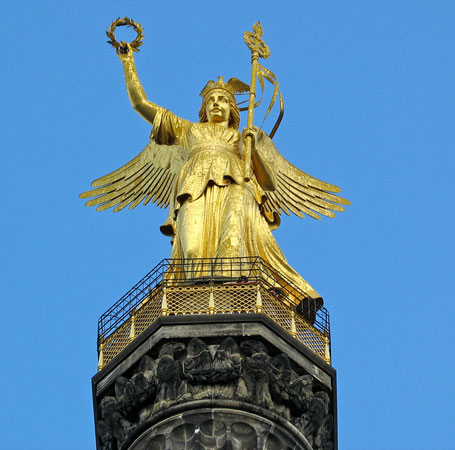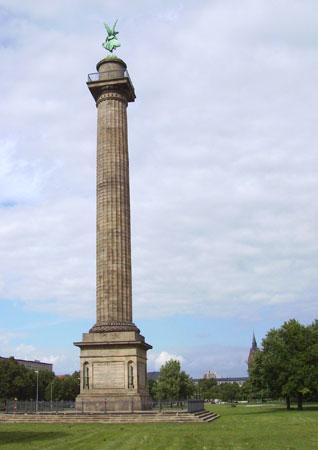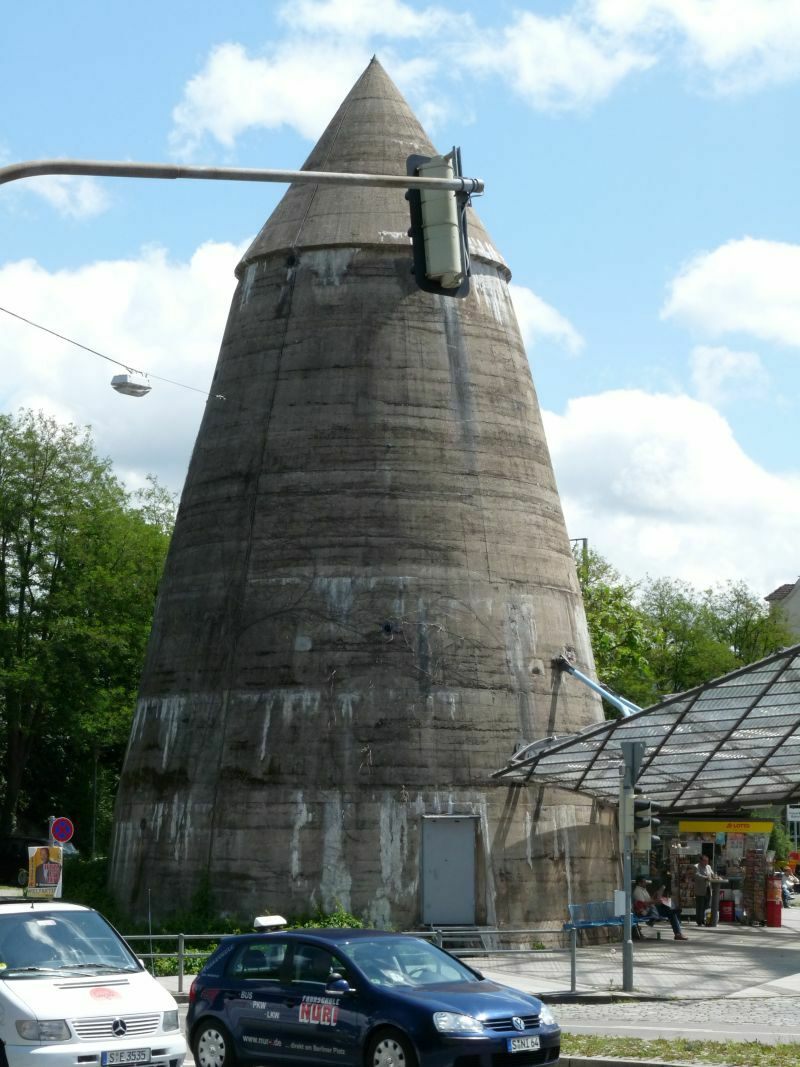Points of Interest
Alexanderplatz
Berlin 10178, Germany
Alexanderplatz is one of Berlin's most famous squares and Mitte's main transport hub. Named after an 1805 visit by Russian Czar Alexander I, the large market square has been in existence since the Middle Ages, when it was known simply as "Ochsenmarkt" (Ox Market). Following the reunification of East and West Berlin, Alexanderplatz underwent numerous changes in the name of westernization, and yet the mix of socialist and western architecture on view here still makes it one of the most fascinating parts of Berlin. Today Alexanderplatz continues to develop in a literal sense and a figurative one too, poised as it is to become the lively center of Berlin yet again. Go here to see the World Clock, Fountain of International Friendship, TV Tower, and many more of the city's top monuments.
Amalienburg
Schloß Nymphenburg 19
Munich, Germany
The hunting lodge of the Electress Maria Amalia, Amalienburg was built between 1734 and 1739 and is considered a masterpiece of European rococo architecture. The architect, François de Cuvilliés, was a major proponent of this style. The interior, by Johann Baptist Zimmermann and Joachim Dietrich, is built around a circular Hall of Mirrors decorated in the Bavarian national colors, silver and blue, to produce an ethereal atmosphere. Some interesting features are the design of rooms in a cluster, the precious Delft tiles that decorate the kitchen, and the kennel for hunting dogs.
Bavarian National Museum
Bayerisches Nationalmuseum Prinzregentenstraße 3
Oberschleißheim, Munich, Germany
There is so much to see at Bavarian National Museum that even the toughest critics will find several objects of interest to pass at least a few hours. Founded by King Maximilian II of Bavaria in 1855, it is renowned for both its original building style and collection of German cultural artifacts. The historical collection, arranged in 40 rooms, contains artworks in Romanesque, Gothic, Renaissance, Baroque, Rococo, Classical, and Art Nouveau styles; sculptures from different ages; ivory and gold works; textiles; glass paintings; tapestries; and shrines. Also on display are musical instruments, furniture, oil paintings, sketches, clocks, stoneware, majolica, miniatures, Nymphenburg porcelain, and faience (glazed earthenware), all of which reflect the culture of courtly life. The museum's folklore section has a representative collection of traditional Bavarian furniture, rural pottery, and religious folk items.
Bellevue Palace
Schloss Bellevue Spreeweg 1
Berlin 10557, Germany
This immaculate white neoclassical palace, in the northwestern section of Tiergarten district on the banks of the river Spree, is the official residence of the German president. Erected in 1786 as a regal residence for Prince Ferdinand of Prussia on what was then a private hunting ground, it has undergone many incarnations from its beginnings as a three-winged weekend retreat for Friedrich the Great's brother, among them a school under Kaiser Wilhelm II and a Reich guesthouse. The present version is a 1959 reconstruction, in which only one original room exists, the Oval Saal (Oval Office). The palace's location in the heart of Berlin, near the Victory Column, Bundestag, and Brandenburg Gate, makes visiting convenient.
Benrath Palace
Schloss Benrath Benrath
Düsseldorf, Germany
In the south of the city lies the late-baroque castle Schloss Benrath, which features not only the Museum für Europäische Gartenkunst (Museum for European Garden Art) but also a spacious park with a mirroring pond, an English landscape park, and a French baroque garden on 60 hectares. Visitors can stroll around among old trees, sculptures, and flower and herb gardens.
Berlin Cathedral
Berliner Dom Am Lustgarten 1
Berlin 10178, Germany
Often referred to as the "Protestant St. Peter's," the awe-inspiring Berliner Dom dates back only to 1905; but numerous other churches have previously existed on the site, beginning with the 15th-century St. Erasmus Chapel. The present structure is the largest 20th-century Protestant church in Germany. It incorporates baroque and Italian Renaissance influences. Bombing damage necessitated the late-20th-century restoration of its defining domes and ornate baroque interior. The best place to view the intricate mosaics adorning the dome is from its gallery. Other notable interior artwork includes stained-glass windows and a neo-baroque pulpit. The crypt holds more than 80 tombs of Prussian royalty, including those of Frederick I and his wife Sophie Charlotte.
Berlin Philharmonic
Berliner Philharmoniker Herbert-von-Karajan-Straße 1
Berlin 10785, Germany
One of the world's finest orchestras, hence tickets may be difficult to come by. The orchestra was founded in 1828 and has played a leading role in the musical life of Berlin for close to 120 years. The lineup of guest conductors to have graced its stage is a who's who of classical music: Brahms, Grieg, Mahler, Strauss. The original performance hall was destroyed in 1944, but the new Berlin Philharmonic Hall went up in 1963 at the Kemper-Platz in Tiergarten. Designed by Hans Scharoun, the building is frequently cited as a wonder of modern architecture, with its bold yellow expressionist exterior and an interior that features a unique seating scheme in which spectators are seated around the orchestra in irregularly placed terraces beneath a tented ceiling.
Berlin TV Tower
Berliner Fernsehturm Panoramastraße 1A
Berlin 10178, Germany
A one-time symbol of the GDR government that was constructed it in 1969, the needle-topped 368-meter-tall (1,200-foot-tall) Fernsehturm lights up the Berlin skyline. The centrally-located tower, found on Alexanderplatz adjacent to the Berliner Dom (Berlin Cathedral), is the fourth-tallest freestanding structure in Europe. It is visited by over a million people each year. No longer a demonstration of the socialist party system, today it's a reminder of reunified Germany and a top Berlin tourist attraction, housing an observation deck at 203 m (666 ft), a bar, and a restaurant. While the tower is an impressive sight from almost any point in the center, especially at night, those making the journey to its top will be rewarded with a breathtaking panorama of the city.
Bockenheimer Warte Subway Entrance
31 Senckenberganlage
Frankfurt, Germany
This clever entry to one of Frankfort’s subway stations appears to be a tram that didn’t quite make it to its destination. Appearing as though it were traveling right into the ground, including the appearance of concrete that has been gouged up, this tram is actually the entrance to the Bockenheimer Warte subway station. Designed by architect Zbigniew Peter Pininski, his clever depiction may have appeased some of the city’s disgruntled residents who debated and often opposed new construction to the city’s transport network. Completed in 1986, Pininski was inspired by surrealist artist René Magritte. Find the engaging attraction west of the city center and just north of Goethe University.
Brandenburg Gate
Brandenburger Tor Pariser Platz Berlin
Berlin 10117, Germany
The 26-meter (85-foot) neoclassic sandstone gateway to Berlin city was completed in 1791. The basic structure of Doric columns on each side form passages for traffic, and the wider central passage is modeled on the Acropolis in Athens. The Brandenburg Gate has historical significance as the only remaining gate of a series through which one formerly entered Berlin. The gate is crowned by a statue of Victoria, the goddess of victory, riding a chariot into the city. Under Nazi rule, the gate served as their symbol of power. Since the fall of the Berlin wall, the gate has been a powerful symbol of freedom and unity in the country.
Burgplatz
Düsseldorf Germany
The mighty castle of the dukes who ruled Düsseldorf stood at this place. Nowadays, a lonely tower is all that remains. Since the opening of the Rhine embankment tunnel in 1995, Burgplatz—awarded a prize as one of the most beautiful squares of post-war Germany—is again situated directly on the Rhine. The old castle tower houses the Schiffahrt Museum (Shipping Museum), which provides details on 2000 years of navigation on the Rhine.
Cathedral Church of Our Lady
Frauenkirche 12 Frauenplatz
Munich 80331, Germany
The Catholic cathedral of Frauenkirche, the largest church in the Bavarian capital of Munich, can hold a congregation of 20,000 people. The red brick, late Gothic-style cathedral, built between 1468 and 1488 to replace an older church, was consecrated in 1494. The domes atop its two towers are modeled on the Dome of the Rock in Jerusalem and were added in 1525. The interiors include a collection of 14th to 18th century art works by noted artists, stained-glass windows, and the tomb of Emperor Louis IV. A number of legends surrounding the Devil's Footstep have grown around the black mark resembling a footprint with a small hooked tail at the heel at the entrance to the cathedral.
Cathedral of Our Blessed Lady
Frauenkirche Munich, Germany
The Catholic cathedral of Frauenkirche, the largest church in the Bavarian capital, can hold a congregation of 20,000 people. The red brick, late Gothic-style cathedral, built between 1468 and 1488 to replace an older church, was consecrated in 1494. The domes atop its two towers are modeled on the Dome of the Rock in Jerusalem and were added in 1525. The interiors include a collection of 14th- to 18th-century artworks by noted artists, stained-glass windows, and the tomb of Emperor Louis IV. A number of legends surrounding the "Devil's Footstep" have grown around the black mark resembling a footprint with a small hooked tail at the heel at the entrance to the cathedral.
Central Train Station of Hamburg
Hauptbahnhof Hachmannplatz 16
Hamburg, Germany
The Hauptbaunhof is the main train station in Hamburg and is located on the east side of the Altstadt and the Alster lakes. This bustling station, which serves as the starting point for many explorations around the city, is the busiest in Hamburg and just short of Paris's Gare Du Nord in the sheer number of passengers that travel through it each day. Originally constructed in 1906 to replace four terminal stations, the building is another of Hamburg's many architectural treasures, a terrific cast-iron-and-glass structure boasting a 140-meter (460-ft) roof supported only by pillars at each end and a colossal central clock tower.
Charlottenburg Palace
Schloss Charlottenburg Spandauer Damm 10-22
Berlin 14059, Germany
Schloss Charlottenburg is the largest palace in Berlin to survive the two world wars. Started in 1695 as a small country house, it was subsequently expanded by Johann Eosander de Göthe to create an Italian baroque style palace with a turreted orangery at the west end. A new wing with two banqueting halls to complement the orangery was built at the east end and a small theater added during Frederick William II's time. The Belvedere tea house in the park became the venue for family celebrations and later came into use as a residence for some members of the royal family. The park is today a recreation spot.
Chilehaus
Burchardstraße 13
Hamburg, Germany
Chilehaus is one of the most distinctive and aesthetically appealing structures within the Kontorhausviertel, a group of grandiose office buildings designed by architect Fritz Hoeger. The style reflects part Expressionism, part New Relativism, with a dash of Gothic inspiration. This 10-story structure, with the sharpest corner façade of any European building, looks more like a ship out of water than a commercial office building. Its top would be the ship's prow; its façade, made of reinforced concrete and 4.8 million dark Oldenburg bricks, resembles the broad hull of a vast yet somehow delicate sea vessel. The building's commissioner, H.B. Sloman, named this grand structure Chilehaus in honor of the South American country where he'd earned his fortune in the saltpeter trade. The best view of this fantastical architectural work is from the east.
Church of Our Lady
Frauenkirche 14 Hauptmarkt
Nuremberg, Germany
One of Nuremberg's iconic buildings, the Frauenkirche (Church of Our Lady) has been wowing visitors since it was consecrated in 1358. Even Hitler co-opted it as a historic backdrop for a parade through the city: in Triumph of the Will, he is seen saluting as brown-clad ranks march past the church's gabled front. A tremendous example of German Gothic architecture, the Frauenkirche is built mostly of brick, with an impressive stepped gable at the front. At midday every day, the square outside is filled with visitors, who congregate to see the daily show. The Männleiflaufen is a 16th-century clock with a circular blue face that once a day opens up to reveal seven small figures, which glide out, bow, and then disappear. They represent the seven electors of the Holy Roman Empire, paying homage to Charles IV.
City Hall of Cologne
Rathausplatz
Cologne, Germany
The history of Cologne's City Hall mirrors that of the city, with various alterations and extensions expanding the original administrative site. This location dates back as far as the Roman era-this was where the Praetorium was situated—but that's only one piece of the archaeological jigsaw. The Rathaus incorporates elements of the old 12th-century Jewish neighborhood, the 14th-century Hanseatic Hall, the 15th-century Löwenhof (Lion Court) celebrating the independence of the medieval craft guilds, and a Spanish section constructed to mark a 17th-century Iberian alliance. The Jewish links are emphasized by a glass pyramid beside the Rathaus, which contains a traditional mikwe (bath). Amid the earnest architectural styles, a little chaos sneaks into the hall. Keep an eye out, while you're admiring the dozens of statues that decorate the external wall, for a couple of renegade carvings—two of the supposed worthies are pulling a full moon.
City Hall of Hamburg
Rathaus Rathausmarkt 1
Hamburg, Germany
The Rathaus, or City Hall, is an anchor for the city in terms of administration, architecture, and location. At the heart of the Altstadt (Old City) near Binnenalster Lake, the Rathaus serves as the headquarters for both Hamburg's city council and state government, as Hamburg is a city-state. Designed by a team of seven architects, the building was constructed from 1886 to 1897 after the Great Fire of 1842 destroyed the original town hall. Built at a time of great wealth and prosperity, the Rathaus is an ostentatious display of neo-Renaissance architectural flair intended to rival the grandeur of Venice's Piazza San Marco. The building's façade is dominated by an arresting central clock tower adorned with sculptures of Germany's past emperors. From this tower extend expansive verdigris-topped corridors containing 647 impressively elegant rooms (more rooms than Buckingham Palace), most of which are open to visitors.
Collegiate Church
Stiftskirche Stiftstrasse 12
Stuttgart, Germany
The oldest and most important place of worship in Stuttgart, the Stiftskirche (Collegiate Church) is also gorgeously designed. Its golden pulpit, Reformation gallery, and sundial clock are regarded as classic features. Its cemetery houses the remains of many a notable citizen of Stuttgart; in fact, every ruler of Württemberg until 1677 is buried there. From its beginnings as a Romanesque chapel a thousand years ago, this church has endured many wars and the ravages of time. Major renovations in the 1950s and early 2000s restored some, but not all, of the detail lost over the years. These days the Stiftskirche serves as the headquarters of the Lutheran-Evangelical Church in the state as well as the parish church for inner-city Stuttgart, which means that you might chance upon a performance by the choir.
Cologne Cathedral
4 Domkloster
Cologne, Germany
The sheer magnitude and distinctive Gothic features of Cologne Cathedral are truly impressive. Dedicated to St. Peter and the Virgin Mary, the architectural wonder was completed in the late 19th century. It is Cologne's most famous landmark and the second-tallest Gothic structure in the world with two towers rising 157 meters (515 feet). The cathedral boasts the largest free-swinging bell in the world, St. Petersglocke (Bell of St. Peter), which weighs nearly 22 metric tons (24 tons). The cathedral's other treasures include the gilded 13th-century Sarcophagus of the Magi, largest reliquary (container for relics) in the Western world, Gero-Kreuz (the oldest cross north of the Alps), and Milan Madonna (Mailänder Madonna), a wooden sculpture dating to 1290.
Congress Hall
Kongresshalle Bayernstrasse 110
Nuremberg 90478, Germany
An abandoned coliseum intended to be a rallying ground for Nazis, Kongresshalle was designed by Franz and Ludwig Ruff in 1935. Construction of this massive project was halted due to World War II and never completed. Today, the building houses a museum called the Documentation Center Nazi Party Rally Grounds. Exhibits and audiovisual displays featuring artifacts, documents, and photographs chronicle the rise of the Nazi party leading up to WWII and the devastation it caused.
Dammtor Train Station
Dammtorbahnhof Ernst-Siemers-Allee
Hamburg, Germany
One of Hamburg's finest train stations, the Dammtorbahnhof is a turn of-the-century art nouveau edifice composed of steel, sandstone bricks, and glass. The station is one of many art nouveau architectural works one can find scattered throughout Hamburg. This graceful structure, opened in July 1903, took its name from the old city gates that existed at this location until the late 1800s. Running on the Hamburg-Altona line, this station's trains provide local, regional, and long-distance service. To make connections easier, a bus station shares the location. If you visit this attraction early on, note that it's an excellent place to pick up a city map before venturing out to other city sights.
Deutsche Oper Berlin
35 Bismarckstraße Berlin
Berlin 10627, Germany
The Deutche Oper Berlin, designed by architect Fritz Bornemann, opened in 1961 with a production of Mozart's Don Giovanni . In striking contrast to the classic style of the Deutsches Opernhaus, which was destroyed during World War II, Bornemann's concrete facade and sober interior reflects the open, simple elegance of New Berlin architecture. A beautiful, sculptured staircase leads through the ground floor lobby into an impressive foyer with glass panels stretching from the ground level to the top of the building. Thresholds in different hues demarcate spaces. The highly functional auditorium with a capacity of 2,098 seats is notable for its unobstructed view from every seat, excellent acoustics, and precision lighting.
Dyck Castle
Schloss Dyck Jüchen
Düsseldorf 41363, Germany
Schloss Dyck, a moat-encircled castle first mentioned in 1094, is another highlight and one of the most important cultural monuments of this area around the river Rhine. Notably, the structure remained in the hands of the Salm-Reifferscheidt-Dyck family for 900 years until it became the Center for Garden Art and Landscape Design. The castle and English landscape garden not only attract culture buffs and garden lovers but also families for a special day out.
Gehry Buildings
Neuer Zollhof 2–6, Unterbilk
Düsseldorf Harbor
Düsseldorf, Germany
Three shiny and curvy-shaped buildings along the banks of the Rhine River are sure to catch the eyes of those passing by on Düsseldorf Harbor. Designed by American architect Frank Gehry, the modern-looking buildings’ have a wavey appearance, and their exteriors are covered in metallic stainless-steel with white-framed windows. The tallest of the buildings has 14 stories and is nearly 50 meters (164 feet) tall. Completed in 1998, the buildings’ official name is Der Neue Zollhof (The New Zollhof).
Gehry Tower
Goethestraße 13a
Hannover, Germany
In 2001, Hannover became the latest world city to join an exclusive club-ownership of a building by Canadian-American architect Frank Gehry. The gleaming metal tower is a literal twist on the traditional office building. Standing nine stories high, Gehry Tower both cants to one side and rotates, giving it enormous dynamism beside the traditional structures around it on Goethestraße. It is made of iron and concrete, with the cladding composed of stainless steel plates. Whereas most Gehry clients seem to be city museums and cultural centers, this construction was commissioned by Hannover Transport Services. Gehry Tower was not the architect's first collaboration with the German city's design-conscious transit authority. In 1993, he created a curving metal bus stop at Braunschweiger Platz, one of a special series of shelters made by talented British, Spanish, French, and Italian designers.
Gendarmenmarkt Square
Gendarmenmarkt
Berlin 10117, Germany
Established sometime during the late 17th century as the Linden-Markt, this famous square is known for its French and German cathedrals, the Konzerthaus, and the central statue of German poet Friedrich Schiller. The annual Berlin Christmas Market is a popular event in the square. The Französischer Dom (French Cathedral), with a Huguenot museum, a tower extension, and porticos, was completed in 1705 on the model of a destroyed Huguenot church in Charenton-Saint-Maurice, France. After the German unification, the pentagon-shaped Deutscher Dom (German Cathedral) was rebuilt to house a museum of German history.
German Bundestag
Deutscher Bundestag Platz der Republik 1
Berlin 11011, Germany
In 1882, architect Paul Wallot won a competition for a design for the Reichstag (parliament) building. Its construction was completed in 1894, and it housed the German Parliament until 1933. Considered an engineering masterpiece of its time, the building had a cupola of steel and glass. It was destroyed during World War II, rebuilt in the 1960s, and finally reconstructed by the renowned architect Norman Foster for the Bundestag (federal parliament of unified Germany) in 1999. The huge glass cupola on the roof recalls the earlier design. The view of the main hall of parliament in natural light and the view over the city at night from the cupola are major tourist attractions.
Great St. Martin
Gross St. Martin Martinspförtchen 8
Cologne, Germany
Famous for its trefoil (cloverleaf) choir, this massive Romanesque church south of the cathedral has been completely rebuilt since 1948. During World War II, it was gutted by British bombing raids, its tower destroyed, and its walls reduced to ruins. Over nearly 40 years, the city painstakingly restored Great St. Martin—it opened to worshipers once again in 1985. Originally consecrated in 1172, not long after a fire destroyed much of Cologne, the church was built upon the foundations of old Roman harbor warehouses (as well as on those of a 10th-century Benedictine cloister). Over the following three centuries, it was added to and extended, with towers and turrets. Although built mainly in the Romanesque style, Great St. Martin's verticality—its series of piled geometric forms reaching into the sky above the Altstadt—suggests the Gothic style, which was to become prevalent across Germany.
Gürzenich
Martinstraße 29
Cologne, Germany
Completed in 1447, this banqueting hall has huge symbolic status in Cologne. Originally, its size and purpose was an architectural expression of the medieval city's commercial confidence. Holy Roman Emperors were wined and dined here, including Frederick III, Maximilian I, and Charles V. It wasn't just carnivals, masked balls, and banquets; coronations occurred here also. The building is famous for its musical associations-one of Cologne's top orchestras takes its name from the hall. Founded in the 19th century, the Gürzenich Orchestra has premiered pieces by legends including Strauss, Mahler, and Brahms. In World War II, the building was gutted, but its importance to the city made it a post-war priority. Restored with a new glass entrance, which counterpoints the Gothic exterior, it's now a conference center. Don't miss the overlooking view into the 10th-century church of St. Alban, a hollowed-out memorial since the war.
Hunter's Court Castle
Schloss Jägerhof Jacobistraße 2 Pempelfort
Düsseldorf, Germany
Once a hunting lodge for nobles and a temporary residence for Napoleon, Schloss Jägerhof now houses the Goethe Museum and an elegant art collection. Many find the 18th century structure, with its large windows facing a beautiful park and broad, tall, red-washed walls that end in small towers, pleasantly imposing.
Imperial Castle
Kaiserburg Auf der Burg 13
Nuremberg, Germany
The military insurance for Nuremberg's religious and political power for centuries, the Kaiserburg was altered and augmented between the 11th and 15th centuries, by Franks and Holy Roman Emperors alike. The castle is full of fascinating historical details, including exhibits on medieval armor, displays on castle building techniques and defensive tactics, the cylindrical Sinwell Tower to the Tiefer Brunnen (Deep Well), a 47-meter-deep (154-foot-deep) water source. This shaft is one of the guides' favorite features-they lower a tray of candles by rope, or invite visitors to pour water down the well and wait to hear the splash. Look out, too, for the Doppelkapelle, a two-tier space for worship arranged around an atrium. The upper story (reserved for nobles and their families) looks elegant, if a little severe, but the lower space is little more than a crypt. If you have a hankering to stage a reception at the place once owned by Frederick Barbarossa, you can hire the castle courtyard, Rittersaal (Knights' Hall), or Kaisersaal (Emperor's Hall) for private parties.
Jan Wellem's Statue
Jan-Wellem-Reiterstandbild Marktplatz Altstadt
Düsseldorf, Germany
Johann Wilhelm (Jan Wellem in the local dialect) was a beloved duke and ruler of Düsseldorf and the surrounding region during the late 17th century. He is famous for instituting religious tolerance (at the behest of the French) in this largely Protestant region and for his massive and vibrant art collection, which was a prize of the city until his successor inherited land in Bavaria and took the collection to Munich, where much of it can still be seen. The monument to him is considered to be one of the finest in Germany.
KölnTriangle Cologne View
1 Ottoplatz
50679 Cologne, Germany
As far as the eye can see ... the unique view of Cologne from atop KölnTriangle promises not only a special visual feast but a treat for all the senses: feel the wind high above the rooftops, hear the muted sounds of the pulsating metropolis on the Rhine, and let the vast expanse make an impression on you. The viewing platform of the KölnTriangle office tower is at a lofty 103 meters (338 feet) high. Discover Cologne and its surroundings—with a direct view of the neighboring cathedral—in a way you've never seen it before!
—Information provided by Cologne View
Leine Castle
Leineschloss Hinrich-Wilhelm-Kopf-Platz 1
Hannover, Germany
Situated above the River Leine, this multifarious building has enjoyed several lives. In the 12th and 13th centuries, it was home to a Franciscan monastery, which did not survive the Protestant Reformation. In the 16th century, the Duke of Brunswick-Lüneberg chose the site as his base, building a castle to cement his grip on Lower Saxony. It was designed by a French architect, Remy de la Fosse, who was responsible for several 17th- and 18th-century castles across Europe. More than 100 years later, Georg Ludwig Friedrich Laves renovated the structure, adding the six-columned portico that visitors can see today. Though gutted by British bombers during World War II, the castle was restored from 1957 to 1962. Today, it remains one of the epicenters of Hannover's political power, as the home of the Niedersächsischer Landtag (Lower Saxony State Parliament).
Main Tower
Neue Mainzer Straße 52–58
Frankfurt, Germany
An impressive panoramic view of Frankfurt awaits all who travel the 200 meters (660 feet) up to the viewing platform at the top of Main Tower. On clear days, the entire surrounding region is visible including the Wetterau Hills to the north, where the orchards that supply the apples for Frankfurt's favorite beverage are located, and Taunus Mountains to the west with its tallest peak, Großer Feldberg. The tower is actually two structures, one round and the other square, that are connected to each other. When completed in 1999, it was Europe's first high-rise building with a façade made entirely of glass. One floor below the observation deck is a restaurant and bar with huge windows that keep the views coming even as the family breaks for snacks and refreshments.
Marienburg Castle
Marienburg 1
Pattensen, Germany
This picturesque castle, just 30 minutes from Hannover, is worth a visit for its classic fairytale appearance. There are several turrets, battlements, and towers, and any child who is a Harry Potter fan will feel like they’ve been transported to Hogwarts Castle. Wander through 30 furnished rooms or ascend the tower and see expansive views of the surrounding countryside from the viewing platform. Learn about the history of Marienburg Castle and those who built it. The castle grounds includes a cafe and shop, too. Tours are offered, including the Classical Castle Tour with guides attired in historical costumes.
National Theater
Bayerisches Nationaltheater 2 Max-Joseph-Platz
Munich 80539, Germany
The Bavarian State Opera's home base in Munich was commissioned by King Maximilian I of Bavaria and opened in 1818. Karl von Fischer, the designer, used a neo-classic style of architecture. It was damaged by a fire in 1823 and reopened in 1825 to premiere a number of operas by German composers, including Wagner's Tristan und Isolde, Die Meistersinger von Nürnberg, and Das Rheingold, and Richard Strauss' Friedenstag and Capriccio. The 2,100-seat theater was extensively damaged during World War II. Restored and enlarged by architect Gerhard Moritz Graubner, it has seen many world premieres and productions since its reopening in 1963.
Neuschwanstein Castle
Schloss Neuschwanstein 20 Neuschwansteinstraße Schwangau
Bavaria 87645, Germany
King of Bavaria Ludwig II built this 19th century castle in the picturesque setting of the Bavarian and Allgäu alps in homage to Richard Wagner. The idealist king conceived of the castle as a retreat, with every room reflecting the operatic world of Wagner's works, and so rebuilt the old castle ruins at Hohenschwangau using the authentic style of the old German knights' castles. Historians say that Ludwig's loss of authority to the Prussians led him to build a castle where he could still feel like a real king. Today, more than 1.3 million people visit the castle each year.
New Castle
Neues Schloss Schlossplatz 4
Stuttgart, Germany
This baroque palace superseded the Altes Schloss (Old Castle) as the official royal residence in 1805, but only for two years. It was almost completely destroyed in World War II, and so today the architecture is an intriguing hybrid of the old and the relatively new. At night, when countless lights illumine its main hall and fountains, the Neues Schloss becomes a truly magical sight. Tours of this building are no longer possible because it now houses governmental offices, but simply looking at it from Schloßplatz makes for a fun experience and a great photo opportunity.
New City Hall of Hannover
Neues Rathaus Trammplatz 2
Hannover, Germany
One hundred meters (328 feet) above the city stands the turquoise-colored copper dome of the New City Hall, a structure most famous not for its grand exterior, but for its slanted elevator. Following the arc of the dome up inside the hall, this unique ascent is not straight, but travels at an angle of 17 degrees along a series of oak planks that have been shaped into a shallow curve using steam. The resulting views over the rusty red rooftops, Lake Maschsee, and the outskirts of the city are terrific (some say that on clear days, you can see the Harz Mountains). Constructed using more than 6,000 beech pilings, the building was designed in deliberately archaic fashion in 1913 by architects Eggert and Halmhuber. Highlights include the huge mural by Swiss painter Ferdinand Hodler, the Garden Hall restaurant, and scale models that show how Hannover looks today and how it looked during three different periods: 1689, 1939, and 1945.
New City Hall of Munich
Neues Rathaus Marienplatz 8
Munich, Germany
There are many attractions to see at Marienplatz, but its defining feature is the Neues Rathaus, which was completed in 1908. Plan to visit at 11 a.m., noon, or 5 p.m. to catch the figures in the tower's Glockenspiel (carillon) perform the Schäfflertanz, a dance still performed in Munich every seventh year to commemorate the ending of the plague in 1517. The building houses the city's government and mayoral offices, although the restaurant Ratskeller occupies a good deal of the first floor and is popular among tourists. At 10 a.m. and 1 p.m., free three-hour walking tours of Munich in English leave from Mariensäule (Mary's Column).
New Synagogue
Neue Synagoge Oranienburger Straße 28–30
Berlin 10117, Germany
Though the original 1859 structure was largely destroyed by Allied bombing, the Neue Synagoge was restored in 1995, with glorious results. At the time of its consecration in 1886, the synagogue was large enough to seat 3,200 worshippers. Today it is entirely too vast for Berlin's remaining Jewish population and serves primarily as museum chronicling the synagogue's past and featuring temporary exhibits on the history of Berlin's Jewish community. Fragments of the original building and remnants of its interior fittings are also on display. The most impressive element of this monument, however, is its exterior. The synagogue's exotic gilded domes, based on the Moorish architecture of the Alhambra in Grenada, Spain, are some of Berlin's most spectacular.
Nuremberg Castle
Tiergärtnertor Square
Auf der Burg 13
Nuremberg 90403, Germany
Part of the Holy Roman Empire, Nuremberg Castle is a group of medieval fortified buildings encircled by walls in the center of the city. Today, visitors to the site can tour the Double Chapel, climb Sinwell Tower, peer down into a 50-meter-deep (164-foot-deep) well, and explore the Imperial Castle Museum. By booking a room with DJH Youth Hostel Nuremberg, it’s even possible to sleep at the castle.
Nymphenburg Palace
Schloss Nymphenburg Schloss Nymphenburg 1
80638 Munich, Germany
Nymphenburg Palace and its parks are one of Munich's best-known sights, and the magnificence of this once royal residence should make an impression on the whole family. Designed in 1664, the palace was expanded to include two pavilions and stables, an orangery (a greenhouse conservatory to cultivate oranges), and ring of baroque mansions. Of special note are the ceiling frescoes in the Stone Hall (Steinerner Saal) and original baroque decorations in the Gallery of Beauties. The museum in the stables houses the magnificent carriages and sleighs of King Ludwig II as well as a collection of Nymphenburg porcelain from the factory in the palace complex. One of the premier royal palaces of Europe, its façade measures 632 meters (2,073 feet) wide, surpassing Versailles Palace in France. The gardens feature lakes, fountains, a hedge maze, and more. Guided tours and events geared toward children and families are available. See the website for more information and hours.
Oberkassler Bridge
Oberkasseler Brücke Altstadt
Düsseldorf, Germany
Between 1896 and 1898, the city built its first road bridge across the Rhine. At the end of World War II, the bridge was blown up and then replaced by a pontoon bridge. The permanent emergency bridge built between 1946 and 1948 was replaced in 1976 by the present bridge, which was moved on rails to its present position overlooking the Rhine. This is a popular place to take photos of the river and the cityscape with the MedienHafen, Altstadt towers, and Rheinturm in the background.
Old Castle
Altes Schloss Schillerplatz 6
Stuttgart, Germany
The Altes Schloss was founded in 950 CE and was the royal home of the Dukes of Württemberg for several centuries. Its ornate turrets, chapel, and inner courtyard rank as Stuttgart's finest architectural achievements. Impressive also is the large statue of the first Duke, Eberhard. The castle also houses the exhaustive Württemberg Landesmuseum (Württemberg State Museum), which features the Württemberg crown jewels as well as objects relating to ordinary citizens, such as musical instruments and toys from throughout the ages. Non-Germanic treasures include Aztec shields from the 16th century and the oldest preserved card game in the world. An added pleasure is the clock tower, which features model rams that lock horns on the strike of every hour.
Old City Hall of Hannover
Altes Rathaus Karmarschstraße 42
Hannover, Germany
Deserted by the city government, which would later make its home in the neo-Renaissance structure of the Neues Rathaus (New City Hall), this grand old building was all set to be destroyed. But in 1844, a band of Hannover citizens defied the urban planners and persuaded the city to renovate the Old City Hall. Revivalist architect Conrad Wilhelm Hase restored 15th-century details, such as the finials on the five-tiered gables, turning the clock back to the striking medieval Gothic style that was prevalent across northern Germany. Look out for the plaster frieze on the Schmiederstraße wall-it depicts an old Hannoverian game known as the Luderziehen, a sort of arm wrestling in which just the pinkie is used. Although the Old City Hall no longer possesses the same administrative status, it does contain a restaurant, a registry office, and businesses.
Old City Hall of Nuremberg
Altes Rathaus Rathausplatz 2
Nuremberg, Germany
Gutted by Allied bombing during World War II, this 14th-century structure was rebuilt in its existing style after the war. The Old City Hall is composed of several structures built over three different times. The dominant section, the distinctive classical façade with its square towers, was constructed between 1616 and 1622 by Jakob Wolff the Younger. Wolff chose Italian palazzo models for his blueprint, and the interior displays sumptuous Renaissance detailing very different from the original Gothic décor of the older sections. Beneath the Altes Rathaus is the real attraction, the ghoulish Lochgefängnisse (medieval dungeon). Flickering lights: check. Creepy stone corridor: check. Torture chamber: check. Featuring 12 cramped cells (which were usually occupied by two men) and a torture chamber stocked with medieval instruments, this musty subterranean jail is a popular visitor venue.
Old Opera House
Alte Oper 1 Opernplatz
Frankfurt 60313, Germany
The Old Opera House, Frankfurt's major concert hall, playhouse, and former opera house, is known for premiering many important works, including Carl Orff's Carmina Burana in 1937. Designed by Berlin architect Richard Lucae, it was built with public funding in 1880 and reconstructed after 1953 on a citizen's initiative. Acknowledged by international critics as one of the top companies in the world, the Frankfurt Opera maintains a busy and productive schedule of some 200 performances and 70 other events a year. Programs include a mixture of premieres and repertory, including perennial favorites by Wagner, Mozart, Strauss, and Verdi. Mixed in is a selection of contemporary works combined with rarities, and the special events include recitals or chamber music in the opera house foyer. The Old Opera House's Grosse Saal (Large Hall) has a seating capacity of 2,500 seats, while the smaller Mozart-Saal has 700 seats. In addition, there are smaller halls that are used for conventions.
Old Saint Nicholas' Church
Alte St. Nikolaikirche Willy-Brandt-Straße 60
Hamburg, Germany
Like most of Hamburg's churches and other important buildings, Alte St. Nikolaikirche was nearly obliterated during World War II. All that was spared of this 19th-century neo-Gothic church were its tower and spire, once the tallest structure in the world at 441 feet. Today the remnants of this church serve as a reminder of all those who were persecuted or lost their lives in the bloodiest battle of the 20th century. Like the tower at St. Michael's, the Old Saint Nicholas' tower affords visitors fantastic views of the surrounding area, including the Speicherstadt, or Warehouse City. Since 2005, an elevator takes guests to the top several times daily. Next to the tower, a local citizens' organization runs a small museum that showcases the history of the church.
Opera House of Hannover
Opernhaus Opernplatz 1
Hannover, Germany
Home of the highly regarded Staatsoper Hannover, one of the best regional opera companies in Germany, this sumptuous neoclassical structure was originally used as a court theater when it was completed in 1852. It was designed by Georg Ludwig Friedrich Laves, a local architect who worked almost all of his life in Hannover, and was eventually appointed Oberhofbaudirektor (master builder to the royal court) in recognition of his primacy in the city. Laves, a neoclassical specialist, was responsible for many of Hannover's most venerable buildings between 1820 and 1860, including work on Leineschloss, Schloss Herrenhäusen, the Wangenheim Palace, and Waterloo Column. For the city's Opera House, he envisaged a grand entrance, with a Greek pediment, above a portico and colonnade, the latter decorated with the statues of composers and writers. If you can, buy a ticket to an opera so you can see the interior, restored after World War II.
Overstolz House
Overstolzenhaus Rheingasse 8
Cologne, Germany
With its striking gabled façade, this 13th-century townhouse is an exceptional example of Romanesque residential building. It was commissioned by Gottschalk Overstolz, a merchant who had married into money, then made more thanks to shrewd trading in cloth. Built in the 1220s, the house originally combined family rooms with commercial spaces. Located on Rheingasse, it was well placed for access to the harbor. Architects will be knocked out by the Romanesque detailing on the arches and windows, as well as the crow-stepped gabling popular across northern Europe in this period. It was an architect who saved the building-Johann Peter Weyer stepped in to prevent the demolition of Overstolzenhaus, campaigning successfully in the mid-19th century for its restoration. Badly damaged during World War II, it was once again reconstructed in the 1950s. Today, it houses the library and media center of the Academy of Media Arts. Closed weekends.
Red Town Hall
Rotes Rathaus Rathausstraße 15
Berlin 10178, Germany
Rotes Rathaus, literally translated as "Red Town Hall," is the seat of Berlin's Senate, its presiding city-government body, and the mayoral offices. Constructed between 1861 and 1869 by architect Hermann Friedrich Wäsemann, the hulking building with four main wings and generous inner courtyards is instantly recognizable by its red clinker brick façade. A number of unique architectural features make the building worth a look, including four complete stories linked by tall window frames, an overhanging balustrade, and the 74-meter-tall (240-foot-tall) tower rising from its main portal, one of the structure's defining characteristics. Visitors should also take note of the terracotta frieze along the façade, illustrating the history of Berlin until 1871 in a series of 36 panels.
Reichstag Building
Reichstagsgebäude 1 Platz der Republik Berlin
Berlin 11011, Germany
In 1882, architect Paul Wallot won a competition for a design for the Reichstag (parliament) building. Its construction was completed in 1894 and it housed the German Parliament until 1933. Considered an engineering masterpiece of its time, the building had a cupola of steel and glass. It was destroyed during World War II, rebuilt in the 1960s, and finally reconstructed by the renowned architect Norman Foster for the Bundestag (federal parliament of unified Germany) in 1999. The huge glass cupola on the roof recalls the earlier design. The view of the main hall of parliament in natural light and the view over the city at night from the cupola are major tourist attractions.
Rhine Tower
Rheinturm Stromstraße 20 Unterbilk
Düsseldorf, Germany
Completed in 1982, the Rheinturm (Rhine Tower) soars 172.5 meters (566 feet) up into the sky, affording magnificent views of the Rhine and the city from its viewing deck, the self-service restaurant, or the revolving restaurant, Top 180, at the very pinnacle of the tower. An interesting fact: The portholes on the tower form the world's largest decimal clock: from top to bottom, vertically arranged yellow lights-separated by horizontal red ones-show tens of hours, single hours, tens of minutes, single minutes, tens of seconds, and single seconds.
Römer
27 Römerberg
Frankfurt 60311, Germany
One of Frankfurt's most important landmarks, Römer has been city hall since 1405. Destroyed during World War II, it was rebuilt as a three-story complex with redesigned interiors on about 10,000 square meters, with nine houses around six courtyards. The neo-gothic, three-peaked facade depicts the city's history through the Frankfurtia (the female embodiment of Frankfurt city), the four Kaisers (emperors) of the Holy Roman Empire, two city coats of arms, a clock face, and a placard describing the most important facts about the building. In the northeast, mosaics in timber frames feature the phoenix as a symbol for modern Frankfurt's new beginning.
Schnütgen Museum
Museum Schnütgen Cäcilienstraße 29
Cologne, Germany
This 12th-century church is a perfect fit for the medieval antiquities of the Museum Schnütgen. St. Cecilia's is one of Cologne's celebrated 12 Romanesque churches. Used for centuries as a convent for well-born women, it was deconsecrated in the early 19th century, when it was turned into a warehouse and, later, a hospital chapel. After considerable refurbishment following World War II, it was chosen to house the art collection of Alexander Schnütgen, a Cologne clergyman who took advantage of the widespread secularization of the Rhineland to stockpile religious treasures from dozens of regional churches. Among his collection are Carolingian scroll works, windows from the Dom, Gothic busts in the style of Peter Parler, 16th-century stained glass from Altenburg Abbey, Baroque reliquary jars, and Romanesque crucifixes. Though Schnütgen's reputation for prizing away artifacts makes him a somewhat ambiguous figure, his collection is priceless.
St. Bartholomew's Cathedral
Domplatz 14
Frankfurt, Germany
Not actually a cathedral in the strict sense of the word (it was never a bishop's church), St. Bartholomew's acquired the designation when the coronation ceremonies for Holy Roman Emperors moved there in 1562. Don't miss the Elector's Chapel, where the kings were elected from 1356 onward. The cathedral was badly damaged in an 1867 fire, and the neo-Gothic restoration that followed was literally capped when the west tower received its spire, which had been part of the original plans when the tower was built in 1415. The tower's 324 steps can be climbed from April to October; those who venture upward are rewarded with breathtaking panoramic view of the city. The cathedral's museum also is worth a look; it has exhibits full of artifacts that date back to the Middle Ages.
St. Egidien Church
Sankt Egidien Kirche Burgstraße 1-3
Nuremberg, Germany
This 18th-century structure with its Greek portico and its pair of square corner towers, is an architectural palimpsest, containing vestiges of earlier churches. Although it is the only surviving baroque church in Nuremberg, it also holds elements of the Romanesque Benedictine church, which burned down (along with most of the city's grand buildings) in the great conflagration of 1696. Constructed in 1718 in the midst of the upper-class Egidien neighborhood, the Egidienkirche contains several chapels, the oldest of which is still open today. Tour the Wolfgangkapelle, the Tetzelkapelle (a gift from the Tetzel family), but leave the Euchariuskapelle until last-the venerable chapel dates back to the 13th century. Despite the blackened stones of its façade, this Protestant church remains fully functional today.
St. Gereon's Basilica
Gereonskloster 2
Cologne, Germany
Of the 12 celebrated Romanesque churches in Cologne, none earns such comparisons as the Altstadt's geometrically unique St. Gereon. Likened to Hagia Sofia in Istanbul, it's based around a decagonal base which still features Roman masonry, appropriate stonework in a house of worship dedicated to a fourth-century Roman legionnaire martyred for his refusal to honor pagan gods. The 10-sided basilica was begun in the fourth century, supposedly over the graves of Gereon and his Christian comrades. Inside the church, in a niche on the north side, look out for the Blutsaüle, the Blood Column which was once spattered with the sacred blood of the martyred soldier. The central basilica, begun during the rule of Constantine, was augmented through the 11th, 12th, and 13th centuries, notably with two massive square towers. Other interior highlights include Romanesque floor mosaics, the martyrs' tombs, stained glass windows, and the red-painted dome ceiling.
St. James' Church
St. Jacobikirche Hamburg, Germany
One of five primary Lutheran churches in the city, St. Jacobi is hidden off one of Hamburg's main promenades, the Mönckebergstraße. This unassuming yet important church features a 375-foot tower outside and, inside, the largest baroque organ in Europe. The famous Arp Schnitger organ, complete with 60 registers and 4,000 pipes, was built in 1693 and restored in the early 1990s. The organ was made all the more famous when Bach worked his magic on the keys in 1720. Its sounds resonate through central Hamburg every Sunday morning. The church itself was built in the 13th century but was nearly destroyed during World War II. Don't miss wandering the interior of this charmer, not only for its organ but for its three Gothic altars, all built in the 1500s.
St. Lambertus Basilica
Lambertus Kirche Stiftsplatz Altstadt
Düsseldorf, Germany
This beautiful church is an architectural gem of the Altstadt and a site of vast historical importance. It holds relics of Saint Apollinaris, Düsseldorf's patron saint. The twisted tower of the church has made it famous among tourists who enjoy visiting Europe's old ecclesiastical buildings. Whimsical legend has it that the first virgin (tourist or not) to stand before the tower will straighten it.
St. Mary's In The Capitol
St. Maria im Kapitol Cologne, Germany
The largest of Cologne's Romanesque churches, this 11th-century Catholic house of worship is an intriguing amalgam of architectural features. Constructed on the site of a first-century Roman temple, St. Maria is reputedly based on the floor plan of Bethlehem's Church of the Nativity. The borrowed design, featuring a cloverleaf choir, was the brainchild of Abbess Ida, granddaughter of Holy Roman Emperor Otto II. Nor was Ida content with raiding the east for ideas. She also copied the gallery design from the imperial palace chapel at Aachen. As you approach the church from the river (the eastern end), look out for the arching strips near the top of the choir walls. They're known as "Lombard bands," and they became popular in northern Italy, another architectural addition to the Abbess's diverse church. The interior is just as interesting, featuring works including a pair of intricately carved 11th-century wooden doors.
St. Pauli Elbtunnel
Bei den St. Pauli-Landungsbrücken
Hamburg, Germany
Stretching for 426 meters (1,398 feet) beneath Hamburg’s Elbe River, St. Pauli Elbtunnel opened in 1911. It connects the north side’s city center with the industrial south side. Vehicle lifts, a pedestrian lift, and staircase can be used to access the 24-meter-deep (80-foot-deep) tunnel, which is lined with white tiles and artistic plaques from the 1900s. Pedestrian walkways along each direction of traffic are available.
St. Peter’s Bell
St. Petersglocke Domkloster 4
Cologne 50667, Germany
Cast in 1923, the world’s largest free-swinging bell hangs in the south belfry of Cologne Cathedral. Still ringing today, the iron bell weighs 23,587 kilograms (52,000 pounds), stands 3 meters (10 feet) tall, and measures 3 m (10 ft) in diameter. Visitors can climb the stairs to stand under the bell, when it isn’t ringing of course because otherwise they might go deaf.
St. Sebald's Church
St. Sebald Kirche Albrecht-Dürer-Platz 1
Nuremberg, Germany
It's hard to see where one wall ends and another begins, but the architectural styles are unmistakable for visitors at St. Sebald's. Walk down the nave and you'll see Romanesque detailing, from the arches to the roof. Then move through to the east choir, and it all turns Gothic. First consecrated in 1273, the church is saturated with beautiful art, from the Sebald Chörlein (the Oriel window which juts out of the exterior wall) to the saint's shrine, cased in a 1519 brass structure created by Peter Vischer. Do not miss the crucifix by Veit Stoss. This Nuremberg craftsman, whose magical work with wood earned him commissions from kings and emperors, was forbidden from leaving the city, and was later branded when he accepted work elsewhere. Who was Sebald? A hermit who lived nearby, and who received papal support for his preaching.
Stuttgart Television Tower
Fernsehturm Stuttgart Jahnstraße 120
Stuttgart, Germany
Recognized as the world’s first television tower, Fernsehturm Stuttgart offers memorable views from inside. The tower is 217 meters tall (711 feet) and made from reinforced concrete, with many other facts including the building’s history explained in the information center. See the countryside and city of Stuttgart displayed through panoramic views. The two-story viewing platform is located at 150 meters (492 feet), with the second level built just for children. A restaurant is located at the base of the tower, and a café is found at the top—a great place to linger over food with a view. Experience the engineering marvel that was replicated the world over, from Johannesburg, South Africa to Wuhan, China. A shop offers souvenirs by which to remember Stuttgart’s television tower.
The Gehry Buildings
MedienHafen near the Platz des Landtages
Düsseldorf, Germany
Much has been said about Düsseldorf's older architecture, visible throughout the city, but for locals, the three stunning Gehry buildings will help set the city apart for generations to come. Functional, beautiful, and unique, the buildings are part of the MedienHafen (Media Harbor) district, a conscious repurposing of the city's waterfront in keeping with Düsseldorf's extensive efforts to revamp and renew its image as an international city of fashion and culture.
The Little Monastery
Klosterle Marktstraße 71 Bad Cannstatt
Stuttgart, Germany
This medieval monastery is the oldest structure in Stuttgart and a beautifully restored example of Gothic architecture. It was built in 1463 by the Beguines, a Roman Catholic sect known for its charitable goodwill. Today, it houses an upscale restaurant, Weinstube Klosterle, which serves gourmet spins on Swabian cuisine. The charming little museum inside relates the history of the Bad Cannstatt district from the Ice Age through to its importance as a spa town. The Klosterle is situated on one side of the elegant Wilhelms-Brücke (Wilhelm's Bridge), an attractive sight in its own right.
Victory Column
Siegessäule Großer Stern 1
Berlin, Germany
This Tiergarten icon, rising up 70 meters (225 feet) from a red-granite base in the midst of a traffic circle near the Brandenburger Tor (Brandenburg Gate), is one of the most recognizable Berlin monuments. Built in 1864 to commemorate the Prussian victory in the Danish-Prussian War, it was further ornamented in honor of later triumphs with the addition of the magnificent gilded figure at the top, an 8-meter (26-ft), 35-ton Goddess of Victory. The base is adorned with bas-reliefs of battles, and further up the column a mosaic frieze by Anton von Werner portrays the founding of the German Empire in 1871. An observatory at the top of the Siegessäule affords terrific views of the city.
Waterloo Column
Waterloo Säule Waterlooplatz
Hannover, Germany
As the sun fell on the evening of June 18, 1815, the Battle of Waterloo hung in the balance. For more than a decade, British and French forces had fought across Western Europe. And after six hours of combat, it still wasn't clear which side would emerge victorious. Enter the Prussians of Field Marshal Blücher, whose late intervention tipped the balance against Napoléon. With 50,000 casualties on a single day, Waterloo was one of Europe's bloodiest battles, and it marked a decisive shift in the continental balance of power. Buoyed by the victory, the German states of Prussia and Hannover would both prosper from their participation on the winning side. On a quiet stretch of grass in the east of Hannover, a 46-meter Doric column commemorates the battle. At the base, an inscription on the plinth reads: "For the heroes of Waterloo, from a grateful fatherland." Designed by Hannoverian architect Georg Ludwig Friedrich Laves, the column was unveiled on the anniversary of the battle in 1832.
Winkel Tower
Near Stuttgart Central Station
Arnulf-Klett-Platz 2
Stuttgart, Germany
Those interested in recent history, particularly World War II, may most appreciate a visit to this bomb shelter. Designed by Leo Winkel in 1934, approximately 200 of the towers were built throughout Germany to protect Nazi forces during World War II. The cone shape of the top was though to deflect bombs, sending them down to the better-fortified base of the towers. The appearance is missile-like and a stark reminder of the events that shook the world. Once thought to be indestructible, in the end they were not. Large enough to hold up to 500 people, Stuttgart’s remaining Winkle Tower is located near the city’s main rail station, at Arnulf-Klett-Platz 2.
Copyright © 1993—2025 World Trade Press. All rights reserved.

 Germany
Germany 